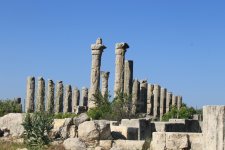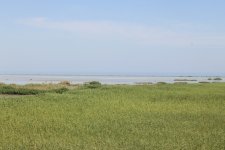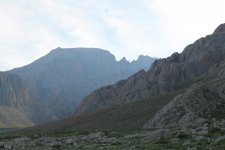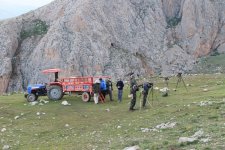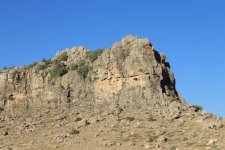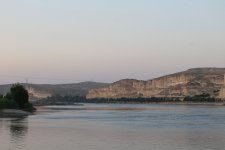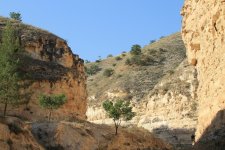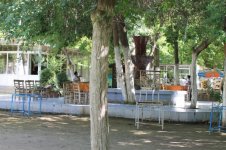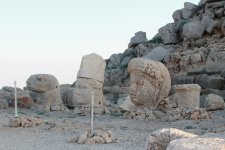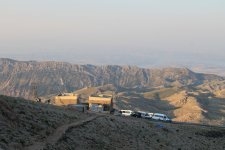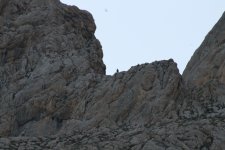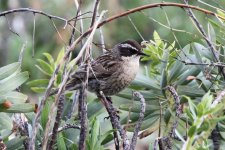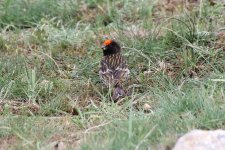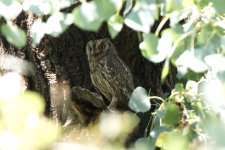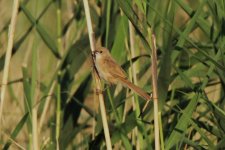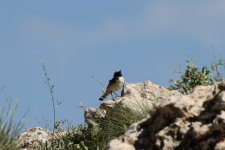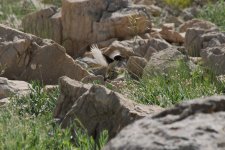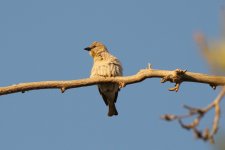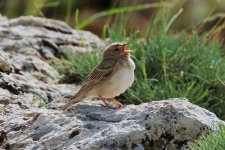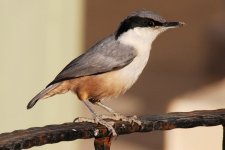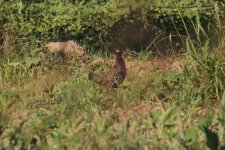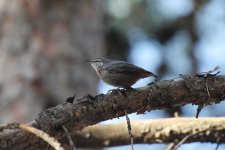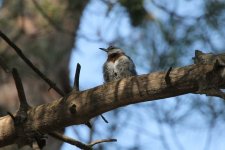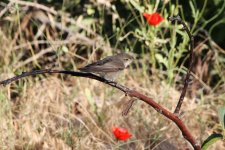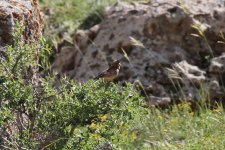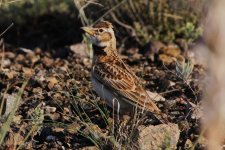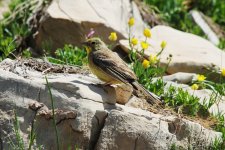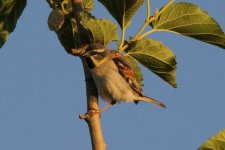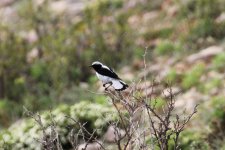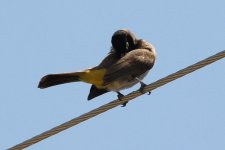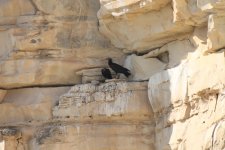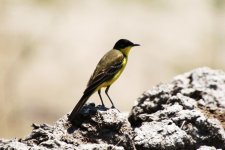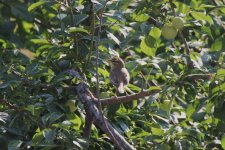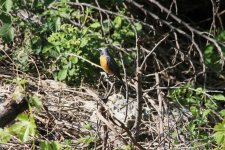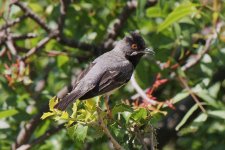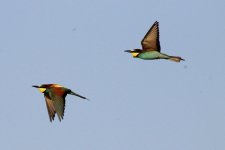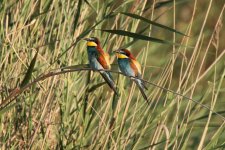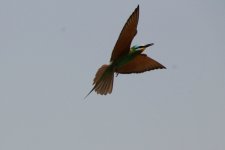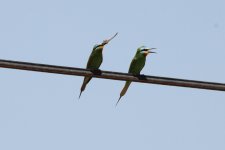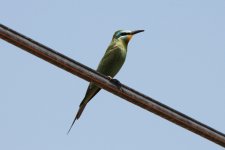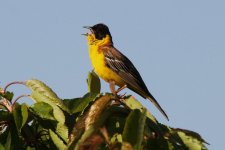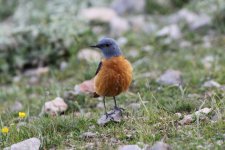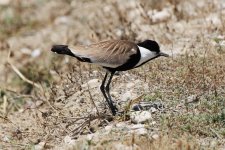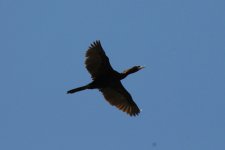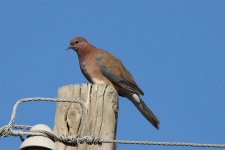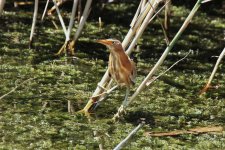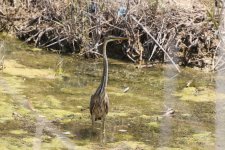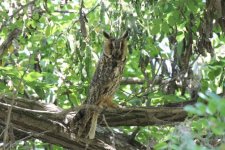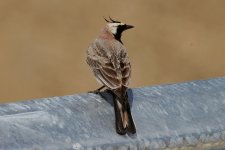Paul Chapman
Well-known member
Turkey - Uzuncaburc, Demirkazik, Durnalik, Birecik & Nemrut Dagi - 02-10.06.12
Between 02.06.12 and 10.06.12 with four friends, I made a trip to Turkey.
We flew into and out of Adana from Heathrow via Istanbul. We had decided not to go as far west as Antalya for Brown Fish Owl or further north or east for specialities such as Grey-necked Bunting, Mongolian Trumpeter Finch, Caucasian Black Grouse, Green Warbler etc. So we were travelling the very well worn paths of Uzuncaburc, the Goksu Delta, Demirkazik, Havutlu, Durnalik/Isikli, Birecik and Nemrut Dagi (near Adiyaman). The paths were so well worn that we bumped into at least three other crews travelling the same type of route in the same order at three of the sites. The largest concentration of birders was around a dozen at Gulhane Tea Gardens at dusk on 05.06.12.
We had a large number of targets. One of us had visited Turkey and Israel before (so had half a dozen targets), two of us including me had visited Bulgaria and Israel but not Turkey (so had between fifteen and twenty targets) and two had visited Bulgaria but neither Israel nor Turkey (so had more than thirty targets).
We had a very successful trip. In total, between us, of the 38 main targets, all of us saw 37 (one missed See-see Partridge) and I had the bonus of Eleanora's Falcon (which I had marked as a possibility but not a target). In addition, it was good to see a number of species which I had previously only seen in Britain as a result of a rather nasty twitching habit - Blue-cheeked Bee-eater, Ruppell's Warbler, White-throated Robin and Little Swifts.
There are a large number of trip reports and in particular, I found the following useful:-
26.06-18.07.04 - http://www.birdtours.co.uk/tripreports/turkey/turkey19/turk-04.htm
28.06-13.07.08 - http://www.fssbirding.org.uk/turkey2008trip.htm
September 2009 - Moning & Taurer - Birding at the edge of the Western Palearctic - Between Euphrates and Taurus Mountains (currently I cannot find a web link - the maps in this report are excellent)
Also, to be highly recommended, is the Gosney Guide to "Finding Birds in Turkey - Ankara to Birecik". It is the sort of trip where it pays to work out the targets and sketch the itinerary whilst keeping various back up sites up your sleeve if anything proves particularly tricky. In broad terms, most things fell into place for us fairly easily.
Temperatures at times climbed to around 42 degrees Celsius and a pragmatic approach to getting in the field as early as possible and birding from shade or the car thereafter was clearly sensible. Occasionally there is no alternative but to fulfil the 'mad dogs and Englishmen' theme.
Before we had left, we had booked our first night's accommodation at the Sabah Hotel, Kizlaseki and our last night's accommodation at the Hotel Mercan, Adana so we did not have the concerns of seeking accommodation either side of our flights to and from Adana. We had also booked our second and third night's accommodation at the Ozsafak Pension - http://www.ozsafak.net/, with a trip to the mountain to look for Caspian Snowcock on either 04.06.12 or 05.06.12 depending on the weather. We had made the arrangements via e-mail - [email protected]. For two nights' accommodation with breakfasts and evening meals including the trip up the mountain, friendly and useful advice - including the loan of a map - and a couple of beers, we paid under £80 each which irrespective of usual local rates, we considered to be excellent value for money and I would heartily recommend.
02.06.12 - Saturday
We left Clevedon at around 6.30am and negotiated things in an entirely uneventful manner to board our 11.25am Turkish Airlines flight to Istanbul from Heathrow. I would recommend Turkish airlines. We had paid £270 each for the return flights. A day of industrial action in the week before our trip had led to a revised flight timetable from our original destination point Birmingham which meant that we would have arrived at Adana at 3.00am in the morning but Turkish Airlines had been amenable to switching our flights to Heathrow at no extra cost to ensure that we would still be able to make our scheduled arrival at Adana airport at 10.00pm. (This was important because we had arranged car hire and our first night's accommodation.) In addition, the food on board was actually quite good and the internal entertainments systems actually worked on the long haul elements. The selection of 30 films and other activities was enough to pass the journey entirely painlessly.
One piece of advice. We checked our baggage and ourselves through to Adana at Heathrow but were slightly puzzled by an announcement on the flight that we should check the in-flight magazine for whether our eventual destination airport had customs as otherwise we should collect our baggage at Istanbul and then re-check it in to the domestic flight to ensure customs clearance. In fact, the information was not in the in-flight magazine at all and the stewardesses did not know where to find it. After some hesitation at Istanbul Airport (and having waited at the baggage carousel just in case) we concluded that the baggage must be going through direct. We had arrived at Istanbul Airport just after 5.00pm local time. Of interest, the airport produced maybe a couple of dozen Alpine Swifts as well as Hooded Crows and Yellow-legged Gulls. The queues to acquire the compulsory 90 day visa together, once acquired, with the queues for passport control lasted about an hour in total. The visa cost £10 (or alternatively 15 Euros). Thereafter, the short walk to the domestic arrivals and another security screening gave us time for a couple of hours for a coffee. There was a slight delay in our flight to Adana taking off. It was scheduled for 8.20pm but in the end we were in the air around 9.00pm. This resulted in us arriving at Adana airport at around 10.30pm. A forlorn wait by the baggage carousel left us wondering how long we could get by with the clothes in which we were standing. Importantly, I had my binoculars, camera and map together with the site information in my hand luggage and a couple of our party had their telescopes so we could function as a birding unit. But a smelly week beckoned!
However, we were pleased when after about fifteen minutes, I noticed that our hire car representative from Europcar was waiting for us. He helped substantially with the language barrier by explaining that our bags would be at the international arrivals so we would need to collect them there and take them through customs. He explained in Turkish to a couple of the airport officials that maybe this should be done to put us and the other twenty or so international travellers that had transferred from Istanbul out of our misery. We were led back onto the airport apron and taken the couple of hundred metres to the international arrivals. The bags were successfully collected.
We had hired a Renault Trafic minibus to ensure that we had sufficient room for a comfortable ride between destinations. In fact, there was masses of room and we were pleased that we had taken this step. It had good ground clearance but at times struggled to cope with loose gravel and soft ground.
We left the airport with bags around 11.40pm. It had been explained by the representative that to use the Toll roads we would need to acquire a KGS card from a Shell garage or the Control Point at the beginning of some of the Toll Roads. This proved easier to say than to do and our attempts at two Shell garages to purchase the card before reaching the motorway resulted in failure. The language barrier in Turkey is pretty substantial. We rarely encountered individuals with English and sign language and miming can only get you so far. It would have been sensible to pay more attention to the rudimentary guidance in the Rough Guide or the Lonely Planet Guide that we had acquired and learn some basic Turkish. The most fluent we became was in ordering 'Omlet' or 'Bal' to accompany our bread. We had concluded from the sign language exchanges that we did not need the card because it was after midnight or it was not required on a Sunday but quite bluntly, the sign language could have meant anything! In the end, on exiting the toll stretch, we went through the Toll Transponder element after the barrier would not rise and no-one was in sight! Our minibus appeared to be fitted with a Transponder in any event.
We arrived at our destination of the Sabah Hotel, Kizkalesi in the early hours. We had chosen this location as a substantial distance towards our first birding site in the morning - the picnic area at Uzuncaburc. (Another crew that we met at Uzuncaburc the following morning had experienced the same charade over their bags at Adana airport having arrived a couple of hours after us and skipped the first night's accommodation to sleep in their cars at Demiricili. I felt suitably shamed at the soft and laid back approach that we had taken!)
03.06.12 - Sunday (Day One)
We left our accommodation at about 6.00am. (Birding light throughout the trip was broadly between 5.15am and 8.00pm - varying obviously between how far east and west you were - so around 15 hours birding light a day.) Before we left, I had heard Yellow-vented Bulbul and we had seen Peregrine. We suffered for the first time from reliance on a few Google Maps print outs and the unfeasibly largescale 1:800000 Euro Map. I quickly bottled cutting north along the minor roads and doubled our journey time! Driving through Silifke, we secured our first target - Laughing Dove. We arrived at Uzuncaburc picnic site just after 7.15am (see the GPS co-ordinates in the Fraser's Birding Report). Within less than ten minutes, we had seen a number of Kruper's Nuthatches. We spent around an hour and a quarter there and between us recorded two Red-footed Falcons, Olive-tree Warblers, Masked Shrikes, more Kruper's Nuthatches and Cretzchmar's Buntings. These were all recorded within a couple of hundred yards or so of the picnic area where we parked. On checking my phone, I noticed a text from a friend that had flown into Antalya with another crew. They had seen Brown Fish Owl that morning. They were now heading east.
We carried on to the ruins at Uzuncaburc itself arriving at around 8.30am. A wander around the site over the next hour produced nesting Syrian Woodpecker, Eastern Black-eared Wheatear and Black-headed Bunting. All three species proved to be relatively common thereafter throughout the trip.
We had passed through Demiricili on the way to Uzuncaburc and we began winding our way back. South of Uzuncaburc, we had travelled through a relatively substantial gorge. A stop on the way back at a suitable point around 10.15am resulted in a pair of Western Rock Nuthatches together with Blue Rock Thursh. We then travelled to and checked the area around the upper cemetery at Demiricili (again see the GPS co-ordinates in the Fraser's Birding Report). Over 40 minutes or so from 11.00am, this produced further singing Olive-tree Warbler and Cretzchmar's Bunting as well as Masked Shrike and one of our specific targets on the first day - Ruppell's Warbler. Both Kruper's Nuthatch and Ruppell's Warbler may have proved tricky for us further east on our itinerary so it was good to have got them out of the way - albeit we did have back up sites which we could have tried.
We stopped for lunch in Sifilke shortly before midday. This proved to be relatively unsuccessful. Not for the last time we discovered that it is far easier to get something to drink than to eat and we settled for a refreshing cold drink in the shade. A nesting White Stork with a well-grown chick in the centre of town was our first of the trip.
After a break, despite the fact that we were now in the heat of the day, we headed on to the Goksu Delta. We spent a couple of hours here from 1.00pm to 3.00pm. Here we tried the track leading south from the Sifilke to Tasucu road - found just east of the garage/petrol station but before the sign Ulugoz - see number 14 in the Moning & Taurer report on the Goksu Delta map and site 12 page 26 in the Gosney Guide. We found the tower hide at the north side at the end of the track but this was in a poor state of repair. Two members of the party succeeded in a bit of free climbing to skip a dozen or so missing steps to make the upper platform. (As far as we were aware, this was not a historic Turkish coalmining monument and we did not ignore any signs.) Their reward was a brief Ferruginous Duck before it disappeared down a channel. Checking the area of the track to the hide and adjoining tracks produced an interesting haul of two Little Bitterns, Squacco Heron, a number of Purple Herons, Marsh Harriers, Spur-winged Plovers, Black-headed Wagtails, a single Rufous Bush Robin, Graceful Prinias, Great Reed Warblers and Bearded Tits. The biggest prize for me was a cracking first-summer pale phase Eleanora's Falcon at around 1.30pm a few hundred yards from the end of the track. I was aware that at least one other trip had seen a bird here in the past but I was also well aware of how lucky I was to have the good fortune to connect!
We gradually drove the tracks west towards Tacusu in the hope of White-breasted Kingfisher. We were aware that if we did not connect here, a specific trip south of Adana would be required later in the trip. Despite searching, we were unsuccessful. As we had ended up at Tacusu, we decided to try the tower hide in the south west corner of the Delta - see number 6 in the Moning & Taurer report on the Goksu Delta map and site 5 page 24 in the Gosney Guide. This proved to be in better condition but the view from the top was a little disappointing with the highlight being two adult Purple Swamphens together with six young.
It was time to depart and we set off shortly after 3.00pm in the direction of Demirkazik. Before we got to the Toll Road, on this occasion, we successfully purchased a KGS card from a Shell garage and topped it up with 20TL in anticipation of the balance of the trip. The journey was relatively uneventful. Turkish driving was not the worst that I had encountered but there were some 'local customs' with a rather cavalier attitude towards traffic lights and overtaking on both sides. En route, we had called ahead to our accommodation to check that food was available in the evening. We arranged dinner for 8.30pm.
We stopped on the way out of Camardi to check for Bimaculated Larks at around 7.15pm. We had no luck with Bimaculated Lark but Tawny Pipit was seen and Short-toed and Horned Larks were very much in abundance whilst a Little Owl appeared on a nearby house at around 8.00pm shortly before we left. The mountain backdrop was stunning as the moon rose. We arrived at our destination of the Ozsafak Pension at around 8.15pm and tucked into a pleasant meal and a beer on the balcony. Over dinner one of our party found his name in an entry from August 1991 in the Guest Book of our host's father - a trip on which he had only had one distant call of Caspian Snowcock. This was something he planned to put right the following morning. The crew that we had met briefly at Uzuncaburc were staying at the Pension and would be travelling with us up the mountain the following morning.
So the day ended with ten of the targets secured plus the bonus of the Eleanora's Falcon.
04.06.12 - Monday (Day Two)
Arrangements had been made that our host would be up early to check the weather. If conditions were suitable, he would knock on our doors at 3.45am with a view to setting off at 4.00am. We would drive to the monument at the rear of the Mountain Centre at Demirkazik and thereafter be transported to the top of the mountain to search for Caspian Snowcock. Everything went to plan. The journey up was on the back of a trailer. This felt pretty secure albeit that in areas, the track was on pretty soft ground and the drop alongside the track was pretty daunting.
As the light became better, two Chukar flushed from ahead of us and the occasional wheatear flicked off the track. We arrived at our vantage point - effectively above number 3 in the Demirkazik map in the Moning & Taurer report - at around 5.30am. A couple who we had seen at the start of the track behind the Mountain Centre walking up with a torch were seen again at the top. (We later saw them at Borecik and Nemrut Dagi.) The walk appeared (to me) similar to that from the car park at Glenfeshie to the Dotterel area at Carn Ban Moor - but that's easier to estimate from the back of a tractor and I was glad that we were not walking!
After arriving at the top, almost immediately a Caspian Snowcock call was heard and then the first bird was picked up on the horizon. We stayed at the top of the mountain until around 9.30am. At around 6.30am, a pair of Caspian Snowcock that we had been watching actually flew off the crags above us and down into the valley onto one of the lower grassy slopes. They were then watched on the slope by one of our party who had stayed back at the original vantage point.
The final tally included at least seven Caspian Snowcock with five males and two females, at least five Radde's Accentors - two adults and three fledged juveniles, a pair of Rock Thrushes, at least one Crimson-winged Finch (which gave only poor brief views in flight), Alpine and Red-billed Choughs, Ring Ouzel, Black Redstart, a Wallcreeper in flight, Alpine Accentor and plenty of Snowfinch.
On the way back down the mountain, the journey produced another two Chukar and several Finsch's and Isabelline Wheatears as well as Rock Buntings. Only a few hundred yards before arriving back at our cars, shortly after 10.15am, we had a dozen Red-fronted Serins. These birds were stunning and became my favourite bird of the trip. Around the car at the bottom, we had our first Rock Sparrow and on the way back to the Pension for breakfast, a pair of Golden Orioles gave good flight views. Over breakfast, we had the opportunity for the first time to appreciate the breathtaking nature of the view from the balcony. We had a belated breakfast and a break from 11.00am to midday.
During the balance of the day, there were a number of significant deluges with heavy rain. These occasionally curtailed our birdwatching and I suspect restricted the variety of the birds seen. Firstly, we travelled through Cukurbag and explored the area at the foot of the mountains towards the areas set out on the map on page 15 of the Gosney Guide. We were searching for Bimaculated Lark but had no success. The area produced more Isabelline Wheatears. I received a text from a friend to confirm that he was now in Demirkazik and their crew had had some Crimson-winged Finches in the fields alongside the road before you reach the orchards as you enter the village. We were heading to the Chromium Mine Track to get better views of Finsch's Wheatear (for those that had either seem them briefly on the journey down the mountain or indeed had missed them completely). So en route, we stopped to check the fields but had no success.
On arriving at the Chromium Mine Track - number 6 on the Pinarbasi map in the Moning & Taurer report - at around 2.00pm, the rain had become more persistent. We did the first three or so kilometres to approximately the hairpin illustrated. There was no sign of any Finsch's Wheatears around the cemetery or the start of the track. However, we did have plenty of Isabelline Wheatears as well as Red-billed Chough, Red-backed Shrikes, Horned Larks and Rock Buntings. But the two real prizes were at least three Eastern Orphean Warblers in bushes alongside a rocky slope after about two kilometres at around 2.30pm and a pair of White-throated Robins after about three kilometres at around 2.50pm.
So with good views of Finsch's Wheatear proving elusive, we decided to retry the track heading up the mountain from behind the Mountain Centre. We drove as far as felt sensible to approximately number 2 on the Moning & Taurer Demirkazik map and almost instantly located a pair of Finsch's Wheatears by the side of the track at around 4.20pm. Over the next couple of hours, we subsequently found three pairs including a pair bringing food to a nest some twenty yards or so from the track. Flight views of two Crimson-winged Finches were had by some and checking out the calls of Chukars produced brief views of one before it disappeared back into the rocks. Otherwise, the area abounded with Horned Larks. On the way back down, a single Chukar gave good views and finally, all of us had caught up with this species. Then, we relocated the Red-fronted Serins in the same area as in the morning just after 6.00pm and had a little longer to enjoy good views.
Our final stop of the day was some roadside fields on the way back to the Pension in another attempt at Bimaculated Lark but without success.
Again we stayed at the Ozsafak Pension and again the day ended with a pleasant meal on the balcony with another beer. The number of targets seen had increased to twenty (albeit Crimson-winged Finch remained to be nailed properly).
05.06.12 - Tuesday (Day Three)
We woke to breakfast on the balcony at 6.00am. There was the surprise of a cracking adult Rose-coloured Starling in the top of one of the cherry trees from the balcony. We were on the road before 6.30am. The other crew staying at the Pension had supplied a copy of a Mike Grunwell report - http://www.birdtours.co.uk/tripreports/turkey/turkey25/demikazik-may2005.htm - the night before with which they had secured excellent views of Bimaculated Lark on 03.06.12. I would point out that Mike's experience of the Snowcock experience in 2005 bore no resemblance to our experience with Basar Safak in 2012 which was excellent!
We headed off on the minor road in Camardi towards Cellalar. As we exited Kavakligol, we had our first Bimaculated Lark at 6.45am and good views were obtained. The orchards further on produced our first Upcher's Warbler and again good views were secured of White-throated Robin. The areas as the road climbs higher and gets more grassy were plainly excellent for Bimaculated Lark. We were back on the road before 8.00am and the stop had proved very successful.
The roadworks section of the road back to the motorway produced a Barred Warbler by the roadside as well as a flock of sixteen Rose-coloured Starlings in flight. We stopped at a roadside restaurant before entering the motorway and had our hire vehicle washed for the first time. We never really worked out how to stop this happening - I think that it was washed at least four times over the balance of the trip - probably more. In the end, we tried to hide the vehicle whenever it seemed in danger of another wash to avoid another standoff with the individual that had washed it before a token of his appreciation was provided!
We decided to try and get White-breasted Kingfisher out of the way. We tackled the traffic to head to Havutlu. We stayed on the motorway until we were on the east side of the river and then took the road into Adana. This led to the large mosque from where the Karatas road was signposted. The directions proved to be spot on - see page 4 of the Chris Batty report and the first paragraph under Tarsus Delta in the Moning & Taurer report. After we had taken the right hand turn, at around 11.00am, we had our first White-breasted Kingfisher on wires just at the point where the right hand fork goes along the river. Within that area, we found at least six more together with a Penduline Tit nest in an adjacent tree at the end of the track set out in the Chris Batty report.
After about twenty minutes, we headed off at around 11.30am for the drive to Durnalik. We followed Mike Grunwell's directions to find the site and it proved easy enough. Thereafter, we turned south off the D400. The road climbed and bore left at which point we headed right up the valley and then at its top bore right when the road turned back left to Isikli. There was a left hand turn towards a house and some orchards and at 3.00pm, we parked at that junction where there was a small quarry. The road carried on further to a larger working quarry and on both of our visits the road was pretty busy with quarry traffic. We drove the Durnalik valley relatively slowly and parked up at its head scanning back to the end of the crag - see page 17 of the Gosney Guide.
The next forty minutes or so produced the expected Cinereous Buntings and Eastern Rock Nuthatches - both holding territory. A walk along the bottom of the crag suddenly brought me face to face with a male Red-tailed Wheatear - a decidedly unexpected development! The area had ceased to be a reliable site for the species some years before. Attempts to relocate it failed but after about a further twenty minutes a pair flew out and over us towards the other side of the crag. We sat back and scanned and also picked up Pale Rock Sparrow. Things were going extremely well but only I had had decent views of the Wheatear.
We decided to try the loop of Durnalik and Isikli before returning back to check the crag (see the map of Durnalik and Isikli in the Honing & Taurer report). Firstly, the orchards towards the bottom of Durnalik valley - site 2 on page 16 of the Gosney Guide - produced White-throated Robin, Rufous Bushchat and Upcher's Warblers and then the orchards near Isikli produced Eastern Orphean Warblers. On the road between Isikli and the top of Durnalik valley, more Upcher's Warblers and Pale Rock Sparrows were seen.
We parked up again at the top of Durnalik valley where the track continues on to the house. We scoped back towards the crag and were delighted that after about ten minutes the male Red-tailed Wheatear had reappeared. A real coup! Brief and rather distant scope views were had by the rest of the crew.
Whilst at Durnalik, I had received a text from a friend - who had now leapfrogged us - and gone straight to Birecik. They had secured good views of Iraq Babbler and provided GPS co-ordinates. I've never really been one for patience and wondered how quickly we could get there. We headed off just after 6.30pm.
It was clear that we were not going to be at Birecik until shortly before 8.00pm. This was not enough time to get to the gravel pits for any sensible search so we decided to join the other birders at Gulhane Tea Gardens. This proved slightly trickier to find than expected - see site 8 on page 22 of the Gosney Guide and number 1 on the Birecik map in the Honing & Taurer report. If you are travelling west, as you see the Euphrates bridge appearing in front of you, you take the last left hand turn. This road takes you down a slip road to a one way system where you have no alternative but to bear right at the bottom and then go back under the bridge to swing back round to the left to then travel south alongside the Euphrates. The road bends inland slightly to continue south parallel with the Euphrates along the side of a series of parks/gardens. On your left hand side, after a couple of hundred yards, you will see an arched entrance. You go through that entrance and you will find yourself in the Gulhane Tea Gardens. We had driven around for only ten minutes or so before we cracked it but as dusk was descending, I was having one of my sense of humour failures for the minimal delay. I blame the lack of sleep and the amount of driving!
Our arrival at the Gulhane Tea Gardens brought the total number of birders present on site to about a dozen. A search of the area was failing to produce the Pallid Scops Owl or indeed anyone offering to show it to us! I have never been proud on such topics and had been fully prepared to do a deal at the first opportunity. (I've never calculated the cost of seeing a bird let alone worked out if I could have seen a bird more cheaply.) A juvenile and adult Long-eared Owl were showing however in the far corner of the walled area containing the children's play area. As darkness really set in, an entrepreneur did appear to offer to show us the correct tree for the Pallid Scops Owl on a 'no bird no fee' basis. A total fee of 50TL was agreed between us - so slightly under twenty pounds in total - or less than £2 each. He identified a tree by the archway next to the second parking bay but a search proved unsuccessful. No food was available at the Tea Gardens and being a true entrepreneur and having lucked out with the owl, he then took our orders and arranged for a takeaway Pizza or Kebab to be delivered.
Whilst waiting, there was a brief rush after a small owl was seen in flight departing the Tea Gardens from the vicinity of the tree. The food then arrived. It was clear that there was a 'mark up' involved on the food delivery as the delivery boy's scooter was immediately apprehended on arrival by the local entrepreneur. (It later became clear the following morning that the delivery was from the restaurant a 100 yards or so further west from the Hotel Mirkelam - the Sahra Kebab and Pizza Restaurant.) The food was produced but then there was a proper rush. A Pallid Scops Owl had appeared sitting out in the tree that had earlier been identified and good views were had in the torchlight. The food as you can imagine tasted all the better for the suspense, the interruption and the later success!
A detailed map was drawn by the crew that had arrived in Birecik earlier showing the location of that day's Iraq Babblers (and Dead Sea Sparrows) at Birecik gravel pits and the same crew that had stayed in the Ozsafak Pension at Demirkazik explained where they had seen Menetrie's Warblers and See-see Partridge at the Bald Ibis Gulley that afternoon. With Pallid Scops Owl under the belt, hopes were high for our remaining targets.
We settled up including the success fee for the Owl and arrived at the Hotel Mirkelam, Birecik shortly before 10.00pm. We paid 25 TL each per night in cash up front - so less than £10 each. Albeit a significant element of the day had been spent in driving, each of the sites that we had visited had delivered well. The number of targets secured had increased to twenty eight (with better views of Crimson-winged Finch still needed).
06.06.12 - Wednesday (Day Four)
We were up and out at dawn - well shortly after 5.00am. On arriving at Birecik Gravel Pits, we immediately secured good views of Black Francolin from the main track. We then followed the directions kindly provided from the night before at the Gulhane Tea Gardens. This involved taking the right hand fork opposite the last (derelict) building as you approached the gravel pits, ignoring the first right turn thereafter and taking the second right turn, before parking up by a bund by the second right turn thereafter. Effectively, this was close to the lowest arrow at number 9 on the map on the Honing & Taurer report. As we got out of the vehicle, three Pied Kingfishers were seen, together almost immediately thereafter with the first Dead Sea Sparrows in the orchards alongside where we were parked. The first Iraq Babblers then appeared in the adjacent reeds. They gave good views and the other highlight was a brief Wryneck. A drive around the site before we left produced another Pied Kingfisher fishing alongside the Euphrates. Desert Finch had been seen in the orchards the night before but we had no luck in that regard. This was a species that I had not seen on my Israel trip so it was a particular target. We left the gravel pits around 6.30am.
We decided to head to the Bald Ibis Wadi before the temperature climbed too high. This is site 2 on page 19 of the Gosney Guide and at number 3 on the Honing & Taurer map. We parked up by the centre before 7.00am and walked down into the wadi. One of our party is restricted in his mobility and it was rapidly clear that he would be unable to travel too far down the wadi. However, views of Menetrie's Warblers were instantly secured near the entrance. We met one of the crews from the night before who had seen See-see Partridge that morning and gave us directions. We carried on for a couple of bends until we reached an obvious track leading up the left hand slope to the top. We walked to get to the top and viewed back across the wadi to the far side. After about fifteen minutes, we were delighted that a female See-see Partridge flew in and was seen well as it ran back across the rocky slopes to disappear back out of sight. Satisfied (and knowing that we would be trying again for See-see Partridge later), we headed back down into the wadi and back to the minibus. There had been one well-grown young Bald Ibis on the cliff at the start of the wadi as we entered. We did not go inside the Bald Ibis Centre but this youngster had attracted an adult before we departed. We also had at least a couple of dozen Bald Ibis giving excellent flight views low over the cliffs as we sat by the vehicle in the shade for fifteen minutes. Other species in the wadi included Rollers and Syrian Woodpeckers but the temperature had climbed rapidly. We left the site at around 8.30am.
We headed north in anticipation of finding the restaurant numbered 10 on the map in the Honing & Taurer report. However, disappointingly, this proved to be derelict. Pressure was on to find somewhere for breakfast. We carried on further north. We had earlier received another text to say that Yellow-throated Sparrows had been showing well at the orchards at site 4 on page 20 of the Gosney Guide and number 6 of the map in the Honing & Taurer report near Ugurcuk. We overshot the site and as I turned round to travel back south along the main road, I was distracted by two cracking Yellow-throated Sparrows on roadside wires. These had gone before views were had by the balance of the crew and as a result, we decided to stop at the orchards behind the cement works to relieve the pressure before returning to Birecik for breakfast. The orchards duly produced Dead Sea and Yellow-throated Sparrows and another target was under the belt. We headed back towards Birecik at about 9.30am.
On returning to Birecik, we visited the Sahra Restaurant for breakfast and watched our vehicle getting washed. Thereafter, we had to visit a bank to change some currency and it was around 11.30am that we set off for the Fish Farm south of Birecik. This involved finding the road south and following it for around 7 or 8 kilometres over two level crossings. After the second level crossing, you turn left to follow the track for a further kilometre or so until it arrived at an area of gravel pits alongside the Euphrates. We were now in the heat of the day - arriving about midday - and the temperature was over 40 degrees celsius. We were looking for large gulls but we saw none. We drove a little way further south but found no additional vantage point. A sprinkling of rather typical species included lots of Pygmy Cormorants along with Night Herons, Squacco Herons, Greater Flamingo, Little Ringed Plover, two pairs of Ferruginous Duck, Spur-winged Plover, Black-winged Stilts, Caspian Tern and Black-headed and Slender-billed Gulls. [The next day we had a text to say that one of the other crews had good views of Armenian Gull there that morning but we did not return.]
We headed back to Birecik and the Gulhane Tea Gardens to get out of the sun. When we were there, it felt our duty to check the Pallid Scops Owl tree from the night before. Despite being a little pessimistic as to our prospects in light of the previous day's experience, a little after 2.00pm, this resulted in not one but two Pallid Scops Owls being found. Eventually an angle was found to see one of the birds almost completely unobscured but from slightly further away. Checking the Long-eared Owl area produced an adult bird and whilst we were viewing that we were approached by some schoolchildren to whom we gave views of the Long-eared Owl through one of our scopes. One child gave the international sign language equivalent of asking whether we wished to be shown a smaller owl. We took him up on his offer and about fifty yards or so outside the walled compound at around 3.40pm he showed us a third Pallid Scops Owl - remarkable! We tipped him at a fraction of the previous night's negotiated fee.
In the morning, we had tried to pick up Little Swift from the Birecik to Ugurcuk road so we headed back north to try our luck again. Stopping on the verge before the Bald Ibis wadi at around number 4 on the Honing & Taurer map immediately produced results with good views. We still had the issue of See-see Partridge and the next few hours were spent scanning from the road east of Birecik and driving the minor roads south of the road around number 11 on the Honing & Taurer map. However, this was unsuccessful and despite a brief stop in the same area on the way out of Birecik the next day our sole sighting of a See-see Partridge remained the one seen at the Bald Ibis wadi in the morning.
We dropped one of our party back at the hotel and headed back to the orchards at Ugurcuk arriving at around 5.50pm. A similar selection of species was seen - Yellow-throated and Dead Sea Sparrows, Rufous Bush Robin, Syrian Woodpecker and Hoopoe amongst others. In addition, a single Bee-eater flew over and a brief Olive-tree Warbler was seen. The highlight for me was when another member of the party picked up a male Desert Finch sat motionless in the middle of a tree. Within less than ten seconds, he had kindly 'volunteered' to give up his scope and I was enjoying good views. Heartily relieved. There are clearly species for which individually I do not have the right search image and I pass over. I had formed the view that Desert Finch was one. I must have passed over the species before in Israel and it was good news finally to see one. Before another member of the party had got to the scope, the bird had flown but later reasonable views were had of a pair in flight.
Picking up the remaining member of our party at 7.30pm, we travelled to the Kiyi Restaurant to spend the evening having a pleasant meal and a beer alongside the Euphrates whilst our vehicle was washed again.
We stayed again at the Hotel Mirkelam. The number of targets secured had increased to thirty seven (with better views of Crimson-winged Finch still needed and one of our party not having seen either the See-see Partridge or Desert Finch). We had one remaining target - Blue-cheeked Bee-eater - that had not been seen at all.
07.06.12 - Thursday (Day Five)
We were up and out at a similar time back to Birecik gravel pits. One of our party had stayed in bed for the extra couple of hours and we arranged to pick him up on the way back past. We spent longer on the Black Francolins that morning and had two separate calling males both with two females in tow. We spent some time watching Bee-eaters and Rollers and had a similar selection of back up species including the Iraq Babblers in the same place as the day before.
After picking up the additional member of our party at 7.30am, we then headed back towards Ugurcuk where we split up with three of us checking the orchards and two checking the gulley near the petrol station. Both areas proved productive with Menetrie's Warblers, Dead Sea and Yellow-throated Sparrows, Rufous Bush Robin etc but further Desert Finches proved elusive. We left about 8.30am to head back to the Sahra Restaurant for breakfast. I tried the approach of not making eye contact with the car washer and for fifteen minutes or so it worked. But as soon as we lost our concentration, we looked up to see the vehicle being washed. In light of the fact that this was the third time in less than twenty four hours, we were beginning to form the view that this was a little excessive. Back home I have never felt the need to wash a car!
We checked out of the Hotel and were on the road by 9.00am. We were travelling to Nemrut Dagi. The remaining target was Blue-cheeked Bee-eater and we discussed the route and the two sites that we had. One was Estagflrullah but all we had for directions was that it was the obvious hill viewable from the road. The other was just after the Euphrates crossing on the D875 to Akpinar. We decided to try for the latter. If we dipped, we had the chance to factor in the other site after we had visited Nemrut Dagi.
We picked up bits and pieces on the journey including Bee-eater, Booted Eagle and Short-toed Eagle. Near the Attuturk Dam, we saw two separate Griffon Vultures. After a bit of confusion as to exactly where we would find the site, just as we noticed the disused sand workings on the west side of the road and began to pull in a couple of hundred yards after the river crossing, we noticed a Blue-cheeked Bee-eater perched on roadside wires. We found some shade and spent an hour at the site from around 12.15pm. We only saw one breeding pair of Blue-cheeked Bee-eaters. The male occupied a perch on a stick directly above the nesthole on the east side of the road whilst the female perched more often on the adjacent wires. At one stage, the male caught a dragonfly and flew in to present it to the female. It presented it head first in a similar manner to Common Kingfishers presenting fish and the female then proceeded to eat the dragonfly head first. Proper birdwatching! Also present were a breeding colony of Rollers and some breeding Bee-eaters. We were joined at the site by the same crew from Uzuncaburc, Demirkazik and Birecik who had noticed us by the roadside. They had gone to the Estagflrullah site and seen thirty-seven Blue-cheeked Bee-eaters. Clearly a flourishing colony and a better bet for those planning future trips.
We then headed on to Nemrut Dagi and shortly afterwards had a Long-legged Buzzard mobbing a first year Egyptian Vulture. The journey was otherwise uneventful. We found a nice restaurant mid-afternoon alongside the river between Adiyaman and Kahta and spent a pleasant hour in the shade having a cold drink and something to eat.
We arrived at the Cesme Pension just after 5.00pm. We agreed 40TL each for room, dinner and breakfast so under £15. This is about a hundred yards or so from the entrance barrier to Nemrut Dagi at which the fee is 8TL per person to proceed any further. It is the closest place to sleep to the summit. Shortly after we stopped, we were joined by the same crew from earlier.
Cinereous Bunting were very much in evidence around the Pension. Having dumped our bags in the rooms, we headed up the mountain. A leisurely drive took around thirty minutes and Pale Rock Sparrows and Cinereous Buntings were reasonably routine sights on the route up. At the top, the walk from the car park was harder work than I imagined. In fact, the route up the right hand side (to the eastern terrace) is actually considerably harder work than the route up the left hand side (via the western terrace) so if you are undertaking the walk, I recommend that you go clockwise! At the top of the mountain, we had at least a female and two male Red-tailed Wheatears but views were frustrating and were not seen by one of our party who remained in the car park. We also had at least two Crimson-winged Finches (but again views were frustrating) together with Alpine Choughs, Horned Larks, Finsch's Wheatear, Rock Thrushes and Snowfinches.
At dusk, we headed back down the mountain and the day ended with a pleasant meal at the Pension. We had a number of moth species here attracted to the lights. I have not attempted to identify them all yet - the next job! But some appeared familiar with apparently Portland Ribbon Wave, The Passenger and Striped Hawkmoth as well as two other unidentified Hawkmoths.
We had now seen all of our targets but better views were wanted of Red-tailed Wheatear and Crimson-winged Finch and realistically we still had a chance to get Desert Finch back for one of the party on the way back to Adana.
08.06.12 - Friday (Day Six)
Shortly after 5.00am, three of us headed back up the mountain. Again, the drive up in a fairly leisurely fashion produced around twenty each of Pale Rock Sparrow and Cinereous Buntings. Eventually at the top we finally had more prolonged views of a male Red-tailed Wheatear. Satisfied, we headed back down to meet up with our remaining two colleagues and enjoy breakfast shortly after 8.00am. Over the next hour or so, Cinereous Bunting and White-throated Robin were very much in evidence.
We then headed back up the mountain. We spent four hours at the top including a pleasant enough meal at the cafe at the top whilst scoping our first Ortolan Bunting of the trip singing on the adjacent rocky slope. We had seen a similar selection of species but a perched Crimson-winged Finch still eluded us. We decided to head back down the mountain and check areas as we went. After a couple of kilometres, there is a fairly open meadow. Shortly after crossing that, the road goes through a bit of a gulley. As we drove through, shortly after 2.00pm, a cracking male Red-tailed Wheatear flew alongside the car. We immediately stopped on the adjoining verge and the next hour or so was spent enjoying views of Red-tailed Wheatear on the rocky slopes either side of the gorge as well as Pale Rock Sparrows and Cinereous Bunting. Again, the same crew from the Pension joined us and we were delighted when one of them picked up a pair of Crimson-winged Finches which proceeded to give good views over a fifteen minute period. Satisfied that we had all now had excellent views of each of the targets here, we headed off at 3.15pm to Durnalik.
En route, I was flagged down and stopped for speeding. This was somewhere near Kahta. The police were entirely polite and I was given a fixed fee fine of 154TL. Within the hour, we stopped in Adiyaman at one of the banks (to which the policeman had directed me) to pay the fine and received a 25% discount to 115.5TL for paying within 14 days. Even at the bank, we were offered tea - typically hospitable behaviour. The remainder of the journey took the balance of the day.
As it was only about 10km from Durnalik, we splashed out considerably and stayed at the 5 star luxury of the Dedeman Hotel. This was plush. We paid £40 a head and had a very pleasant meal in the adjoining restaurant pretty much as a final celebration of a very good trip - in light of the fact that the next day was our last birding day of the trip. Our only remaining aim was to get Desert Finch for the member of our party that had missed it at Birecik.
09.06.12 - Saturday (Day Seven)
We were up and out of our incredibly plush surroundings at 6.00am. We headed to Durnalik and spent around four hours checking the orchards and the valley and doing the loop of Durnalik to Isikli. A couple of Tortoises were our first of the trip. We were slightly disappointed by the species selection. Due to the far better time of day, we expected our experiences from Tuesday to be significantly outstripped. But, quite bluntly, we had been spoilt and got used to the fantastic riches that we were seeing. We saw Eastern Rock Nuthatches, Upcher's Warblers, White-throated Robins, Cinereous Buntings and Pale Rock Sparrows. We also had several Sombre Tits in the upper orchards and a singing male Cretzchmar's Bunting. It was with some relief that after a while, having had a pair of Desert Finches in flight, we finally nailed a male perched albeit distantly in the upper orchard and the last member of the party secured good views of this species. We failed to relocate the Red-tailed Wheatears from Tuesday.
At about 10.30am, we started to head back to Adana to drop our hire vehicle off in the evening before getting a decent night's sleep prior to the following day's journey back to Heathrow. On looking at the map, we decided to see if we could find anywhere to search the coastal area south-east of Adana. We headed towards Yurmutalik and then on to Dececiusagi. We were becoming frustrated by the fact that we could not find anywhere that led down to the coast. Certainly, our map was insufficient for that purpose. However, after travelling west through Deveciusagi there was a notice board for the Yurmurtalik Nature Reserve and a turning to the south. We drove the track to the end - a few buildings including a makeshift cafe - arriving shortly after 2.30pm.
On the coastal marsh, we had a group of about thirty Collared Pratincoles and in the area a good supporting cast of Great White Egret, nine Spoonbills, three Black-winged Stilts, twelve Kentish Plover, forty Slender-billed Gulls, good numbers of Little Terns and three Caspian Terns. Of the large gulls present, we tried our best to dig out something interesting. I like to think that I am quite good at stringing large white-headed gulls but the reality was that all looked like normal Yellow-legged Gulls - mostly moulting horrible mid-summer immatures!
After a couple of hours, we traced back our steps to the main roads and headed towards Adana. We dropped off the hire vehicle early evening as arranged and got a taxi to the Hotel Mercan and our booked accommodation. This was about ten minutes from the airport and the taxi was less than 15TL. We headed to the nearest restaurant and again had an excellent meal before getting a good night's sleep.
10.06.12 - Sunday
We rose before 6am and connected with our taxi to Adana airport. Because we were early, we were offered the option of an earlier flight to Istanbul but declined as there were insufficient seats available. The journey was uneventful and went to plan connecting with our Heathrow flight after a wait of a couple of hours at Istanbul airport with minimal fuss and being back home in Clevedon shortly before 7.00pm UK time very satisfied with a trip that had been far more successful than we could have hoped.
Species List
To be frank, we concentrated on the targets rather than a species list. For instance, once we had secured Bimaculated Lark, we did not really look at larks so probably ignored Calandra and Lesser Short-toed Larks at some point and we never really tried to pick out Spanish Sparrows or Pallid Swifts. However, despite the fact that we did only a token amount of coastal and wetland birdwatching, we still reached a combined species list of 165 which was within our expectations for the itinerary of our trip of 160-170 species. We know that other crews saw Long-tailed Tit, Common Rosefinch and Spanish Sparrow in the orchards at Durnalik and Armenian Gull at the Fish Farm south of Birecik. Our combined species list was:-
Mute Swan - Goksu Delta only seen at the Goksu Delta with 5 or 6 (03.06.12)
Mallard - a female plus ducklings seen at the Goksu Delta (03.06.12)
Ferruginous Duck - a single at the Goksu Delta (03.06.12) and two pairs at the fish farm south of Birecik (06.06.12)
Caspian Snowcock - Demirkazik - seven comprising five males and two females (04.06.12)
Black Francolin - Birecik gravel pits male calling plus two others (06.06.12) and next morning two males calling each with two females (07.06.12)
Chukar - two seen on trip up and two on way down in the morning and in the afternoon at least three calling one seen briefly and then one seen well - Demirkazik (04.06.12); two at Nemrut Dagi (08.06.12); and single calling at Durnalik (09.06.12)
See-see Partridge - single female in the Birecik Bald Ibis wadi (06.06.12)
Little Grebe
Great Crested Grebe
Cormorant
Pygmy Cormorant - common at Birecik and at the fish farm south of Birecik - several hundred seen (05.06.12, 06.06.12 and 07.06.12)
Little Bittern - two at Goksu Delta (03.06.12) and one at Birecik gravel pits on the second morning (07.06.12)
Night Heron - common around Birecik (05.06.12, 06.06.12 and 07.06.12)
Cattle Egret
Squacco Heron - single at Goksu Delta (03.06.12) and several at the fish farm south of Birecik (06.06.12)
Little Egret
Great White Egret - single at Yumurtalik Nature Reserve (09.06.12)
Grey Heron
Purple Heron - several at the Goksu Delta (03.06.12) and one from the Kiyi Restaurant, Birecik (06.06.12)
White Stork - surprisingly scarce - less than twenty seen but a few nests including well grown young
Glossy Ibis - two seen around Birecik (06.06.12)
Bald Ibis - the largest group seen was around twenty and seen commonly at Birecik (06.06.12 and 07.06.12)
Spoonbill - nine at Yumurtalik Nature Reserve (09.06.12)
Greater Flamingo - single at the fish farm south of Birecik (06.06.12)
Griffon Vulture - two singles in the vicinity of the Euphrates crossing near the Attaturk Dam (07.06.12)
Egyptian Vulture - single first year en route to Adiyaman (07.06.12)
Short-toed Eagle - two seen en route to Adana (05.06.12) and one seen en route to the Attaturk Dam (07.06.12)
Booted Eagle - single seen en route to Demirkazik (03.06.12); single seen en route to the Attaturk Dam (07.06.12); and one at Durnalik (09.06.12)
Black Kite - single seen en route to Adana airport (09.06.12)
Marsh Harrier - only seen at the Goksu Delta (03.06.12)
Long-legged Buzzard - about a dozen seen - first seen en route to Durnalik (05.06.12) and the last en route to the Yumurtalik Nature Reserve (09.06.12)
Common Buzzard - single at Durnalik (09.06.12)
Sparrowhawk - single seen en route to our last night's accommodation (09.06.12)
Kestrel - about twenty seen in total
Red-footed Falcon - male and female seen circling low at Uzuncaburc (03.06.12)
Eleanora's Falcon - single first-summer pale phase at the Goksu Delta (03.06.12)
Peregrine Falcon - single first morning at our first night's accommodation (03.06.12); single near Demirkazik (04.06.12); and single at Attaturk Dam (07.06.12)
Moorhen
Coot
Purple Swamphen - two adults and six young from Goksu Delta tower hide in south west corner (03.06.12)
Black-winged Stilt - two at the fish farm south of Birecik (06.06.12) and at least three at Yumurtalik Nature Reserve (09.06.12)
Collared Pratincole - around thirty at Yumurtalik Nature Reserve (09.06.12)
Little Ringed Plover - single at the fish farm south of Birecik (06.06.12)
Kentish Plover - at least twelve at Yumurtalik Nature Reserve (09.06.12)
Spur-winged Plover - two at the Goksu Delta (03.06.12); two at the fish farm south of Birecik (06.06.12); and a single at Birecik gravel pits (07.06.12)
Green Sandpiper - about three at Birecik gravel pits (06.06.12)
Curlew - two at Yumurtalik Nature Reserve (09.06.12)
Black-headed Gull - about a dozen at the fish farm south of Birecik (06.06.12) and a single first-summer at Yumurtalik Nature Reserve (09.06.12)
Slender-billed Gull - one at the fish farm south of Birecik (06.06.12); one near Adiyaman (08.06.12); and forty at Yumurtalik Nature Reserve (09.06.12)
Yellow-legged Gull - seen at Istanbul airport (02.06.12) and also about twenty at Yumurtalik Nature Reserve (09.06.12)
Little Tern - about forty at Yumurtalik Nature Reserve (09.06.12)
Common Tern - seen at the Goksu Delta (03.06.12), near Adiyaman (08.06.12) and at Yumurtalik Nature Reserve (09.06.12)
Caspian Tern - single at the fish farm south of Birecik (06.06.12) and three at Yumurtalik Nature Reserve (09.06.12)
Whiskered Tern - at least one seen near Adiyaman (08.06.12)
Feral Pigeon - including some convincing Rock Doves on the cliffs at Demirkazik (04.06.12)
Woodpigeon
Collared Dove
Turtle Dove - maybe half a dozen seen and heard
Laughing Dove - relatively common near urban areas and in cities - for instance over twenty between the hotel and the airport on the last morning (10.06.12)
Cuckoo
Little Owl
Scops Owl - heard at the Ozsafak Pension (03.06.12)
Pallid Scops Owl - single seen by torchlight and three seen roosting all in or near Gulhane Tea Gardens (05.06.12 and 06.06.12)
Long-eared Owl - at least one adult and one juvenile in or near Gulhane Tea Gardens (05.06.12 and 06.06.12)
Swift
Alpine Swift
Little Swift - several seen north of Birecik (06.06.12 and 07.06.12)
Hoopoe
White-throated Kingfisher - at least six south of Adana at Havatlu (05.06.12)
Pied Kingfisher - at least four at Birecik gravel pits (06.06.12 and 07.06.12)
Bee-eater - a single near Ugurcuk (06.06.12) and at least four at Birecik gravel pits, one en route to the Attaturk Dam and at least three at the site near the Attaturk Dam (07.06.12)
Blue-cheeked Bee-eater - a pair at a site north of the Euphrates crossing near the Attaturk dam (07.06.12)
Roller - a relatively frequent site from roadsides and breeding colonies at Birecik gravel pits, Birecik Bald Ibis wadi and the site near the Attaturk Dam
Syrian Woodpecker - the only black and white woodpecker conclusively seen and relatively frequent sightings
Wryneck - single at Birecik gravel pits (06.06.12)
Skylark
Crested Lark
Woodlark - several heard singing at the Chromium mine track (04.06.12)
Short-toed Lark
Bimaculated Lark - at least ten seen and heard along the minor road from Camardi to Celallar mostly beyond Celallar as the road rises to the hills (05.06.12)
Horned Lark - common at Demirkazik and Nemrut Dagi (seen each day within those areas)
Sand Martin
Crag Martin - a few seen up the mountain at Demirkazik (04.06.12)
Swallow
Red-rumped Swallow - relatively common particularly near the coast but also seen at Durnalik
House Martin
Tawny Pipit - seen and heard at Camardi (03.06.12)
White Wagtail
Black-headed Wagtail - relatively frequent at the Goksu Delta (03.06.12)
Alpine Accentor - at least one - likely more - seen at Demirkazik (04.06.12)
Radde's Accentor - at least five seen at Demirkazik - two adults and three fledged juveniles (04.06.12)
Robin
Nightingale
Rufous Bush Robin - over twenty seen - the first at Goksu Delta (03.06.12) and the last at Yumurtalik Nature Reserve (09.06.12) with the orchards near Ugurcuk being reliable on each visit
White-throated Robin - first seen at the Chromium mine track (04.06.12) and commonly encountered thereafter particularly at Nemrut Dagi and Durnalik
Black Redstart - at least four seen up the mountain at Demirkazik (04.06.12)
Wheatear - very common up the mountains at Demirkazik and Nemrut Dagi
Isabelline Wheatear - several seen around Demirkazik (04.06.12)
Black-eared Wheatear - relatively frequent sight
Finsch's Wheatear - at least three pairs along the Mountain Centre track at Demirkazik but not seen near the cemetry or along the start of the Chromium Mine track (04.06.12) and at least one at Nemrut Dagi (07.06.12 and 08.06.12)
Kurdish Wheatear - a pair seen at Durnalik on the first visit but not refound on our subsequent visit (05,06.12 and 09.06.12) and at least four at the mountain top - a female and three males - and two males about half way from the entrance gate to the mountain top in the gorge before the meadow area - Nemrut Dagi (07.06.12 and 08.06.12). The pair at Durnalik were not seen by other crews on either 06.06.12 or 07.06.12.
Stonechat - a pair seen at the start of the Mountain Centre track at Demirkazik (04.06.12)
Blackbird
Ring Ouzel - single seen at the mountain top at Demirkazik (04.06.12)
Blue Rock Thrush - relatively frequently seen in suitable habitat
Rock Thrush - relatively frequently seen at Demirkazik and Nemrut Dagi
Graceful Prinia - a common bird at the Goksu Delta (03.06.12) and Birecik gravel pits (06.06.12 and 07.06.12)
Barred Warbler - single seen en route from Demirkazik to the motorway (05.06.12)
Blackcap
Whitethroat
Lesser Whitethroat - probably the commonest warbler seen
Eastern Orphean Warbler - at least two on a hillside about 2km along the Chromium Mine track at Demirkazik (04.06.12) and another in the orchards at Isikli (05.06.12)
Sardinian Warbler - a single seen between Uzuncaburc and Demiricili (04.06.12)
Menetrie's Warbler - at least four in the Birecik Bald Ibis wadi (06.06.12) and at least three in the wadi near Ugurcuk (07.06.12)
Ruppell's Warbler - two males at Demiricili opposite the higher cemetry (04.06.12)
Cetti's Warbler
Reed Warbler
Great Reed Warbler
Olive-tree Warbler - at least two singing males at Uzuncaburc and one at Demiricili (04.06.12) and another seen near Ugurcuk (06.06.12)
Upcher's Warbler - first seen in orchards above Cellalar (05.06.12) and thereafter at least seven at Durnalik and Isikli on both visits (05.06.12 and 09.06.12)
Eastern Olivaceous Warbler - the second commonest warbler after Lesser Whitethroat
Great Tit
Coal Tit
Blue Tit
Sombre Tit - several seen at the orchards at the top of the valley at Durnalik (09.06.12)
Bearded Tit - seen and heard at the Goksu Delta (03.06.12)
Penduline Tit - birds visiting a nest at Havatlu (05.06.12)
Kruper's Nuthatch - at least ten at Uzuncaburc (03.06.12)
Rock Nuthatch - a pair seen south of Uzuncaburc in the gorge (03.06.12) and at the top of Nemrut Dagi (08.06.12)
Eastern Rock Nuthatch - common at Durnalik on both visits (05.06.12 and 09.06.12) and at the Attaturk Dam (07.06.12)
Wallcreeper - a single seen well in flight at the mountain top at Demirkazik (04.06.12)
Red-backed Shrike - reasonably common around Demirkazik
Woodchat Shrike - the commonest roadside shrike east of Adana
Masked Shrike - at least two at Uzuncaburc and one at Demiricili (03.06.12)
White-spectacled Bulbul - very common - first heard at our first night's accommodation and last seen en route to the airport to drop off the minibus hire
Iraq Babbler - seen on both visits to Birecik gravel pits with up to three (06.06.12 and 07.06.12)
Magpie - an infrequent sight
Jay - common early in the trip particularly the first day and around Demirkazik
Jackdaw
Chough - seen commonly at Demirkazik (05.06.12)
Alpine Chough - up to twenty around the mountain tops at Demirkazik (05.06.12) and Nemrut Dagi (07.06.12 and 08.06.12)
Hooded Crow - very common
Raven - nesting at Uzuncaburc (03.06.12)
Starling
Rose-coloured Starling - single seen well at Ozsafak Pension and a roadside flock of fifteen en route to the motorway from Demirkazik (06.06.12)
Golden Oriole - two seen at Demirkazik (04.06.12)
House Sparrow
Tree Sparrow - a few sightings with nesting birds at the Ozsafak Pension
Dead Sea Sparrow - frequently seen around Birecik being good numbers and nests at the gravel pits and near Ugurcuk (06.06.12 and 07.06.12)
Rock Sparrow - seen at Demirkazik (05.06.12) and around a dozen including several partially melanistic birds at the cafe at the top of Nemrut Dagi (07.06.12 and 08.06.12)
Pale Rock Sparrow - up to three including singing birds at the top of the valley at Durnalik on both visits (05.06.12 and 09.06.12) and around fifteen singing birds between the Cezme Pension and the meadow en route to the mountain top at Nemrut Dagi (07.06.12 and 08.06.12)
Yellow-throated Sparrow - about a dozen in the orchards near Ugurcuk (06.06.12 and 07.06.12)
Snowfinch - common around the mountains at Demirkazik and Nemrut Dagi
Chaffinch
Linnet
Goldfinch
Greenfinch
Red-fronted Serin - at least ten several hundred yards along the track from the Mountain Centre at Demirkazik (05.06.12)
Crimson-winged Finch - a male at the mountain top in the morning and at least two along the track behind the Mountain Centre in the afternoon at Demirkazik (05.06.12) and a pair at the mountain top and a pair at the lower gorge at Nemrut Dagi (08.06.12). The last finally seen well!
Desert Finch - a male perched and two in flight in the orchards near Ugurcuk (06.06.12) and a pair in both the lower and higher orchards at Durnalik (09.06.12). The last finally seen well!
Ortolan Bunting - singing male by the cafe at Nemrut Dagi (08.06.12)
Cretzchmar's Bunting - two males singing at Uzuncaburc and a pair at Demiricili (03.06.12) and a singing male in the upper orchard at Durnalik (09.06.12)
Cinereous Bunting - common at Durnalik with about ten and common at Nemrut Dagi with about thirty
Black-headed Bunting - very common
Corn Bunting
Rock Bunting - maybe six in total at Demirkazik (04.06.12)
Undoubtedly with thought the trip could have been undertaken more cheaply and thoroughly - we took a few more relaxed and expensive options - but however, you do it, I thoroughly recommend the fantastic selection of species on offer in a very pleasant and welcoming country.
All the best
Between 02.06.12 and 10.06.12 with four friends, I made a trip to Turkey.
We flew into and out of Adana from Heathrow via Istanbul. We had decided not to go as far west as Antalya for Brown Fish Owl or further north or east for specialities such as Grey-necked Bunting, Mongolian Trumpeter Finch, Caucasian Black Grouse, Green Warbler etc. So we were travelling the very well worn paths of Uzuncaburc, the Goksu Delta, Demirkazik, Havutlu, Durnalik/Isikli, Birecik and Nemrut Dagi (near Adiyaman). The paths were so well worn that we bumped into at least three other crews travelling the same type of route in the same order at three of the sites. The largest concentration of birders was around a dozen at Gulhane Tea Gardens at dusk on 05.06.12.
We had a large number of targets. One of us had visited Turkey and Israel before (so had half a dozen targets), two of us including me had visited Bulgaria and Israel but not Turkey (so had between fifteen and twenty targets) and two had visited Bulgaria but neither Israel nor Turkey (so had more than thirty targets).
We had a very successful trip. In total, between us, of the 38 main targets, all of us saw 37 (one missed See-see Partridge) and I had the bonus of Eleanora's Falcon (which I had marked as a possibility but not a target). In addition, it was good to see a number of species which I had previously only seen in Britain as a result of a rather nasty twitching habit - Blue-cheeked Bee-eater, Ruppell's Warbler, White-throated Robin and Little Swifts.
There are a large number of trip reports and in particular, I found the following useful:-
26.06-18.07.04 - http://www.birdtours.co.uk/tripreports/turkey/turkey19/turk-04.htm
28.06-13.07.08 - http://www.fssbirding.org.uk/turkey2008trip.htm
September 2009 - Moning & Taurer - Birding at the edge of the Western Palearctic - Between Euphrates and Taurus Mountains (currently I cannot find a web link - the maps in this report are excellent)
Also, to be highly recommended, is the Gosney Guide to "Finding Birds in Turkey - Ankara to Birecik". It is the sort of trip where it pays to work out the targets and sketch the itinerary whilst keeping various back up sites up your sleeve if anything proves particularly tricky. In broad terms, most things fell into place for us fairly easily.
Temperatures at times climbed to around 42 degrees Celsius and a pragmatic approach to getting in the field as early as possible and birding from shade or the car thereafter was clearly sensible. Occasionally there is no alternative but to fulfil the 'mad dogs and Englishmen' theme.
Before we had left, we had booked our first night's accommodation at the Sabah Hotel, Kizlaseki and our last night's accommodation at the Hotel Mercan, Adana so we did not have the concerns of seeking accommodation either side of our flights to and from Adana. We had also booked our second and third night's accommodation at the Ozsafak Pension - http://www.ozsafak.net/, with a trip to the mountain to look for Caspian Snowcock on either 04.06.12 or 05.06.12 depending on the weather. We had made the arrangements via e-mail - [email protected]. For two nights' accommodation with breakfasts and evening meals including the trip up the mountain, friendly and useful advice - including the loan of a map - and a couple of beers, we paid under £80 each which irrespective of usual local rates, we considered to be excellent value for money and I would heartily recommend.
02.06.12 - Saturday
We left Clevedon at around 6.30am and negotiated things in an entirely uneventful manner to board our 11.25am Turkish Airlines flight to Istanbul from Heathrow. I would recommend Turkish airlines. We had paid £270 each for the return flights. A day of industrial action in the week before our trip had led to a revised flight timetable from our original destination point Birmingham which meant that we would have arrived at Adana at 3.00am in the morning but Turkish Airlines had been amenable to switching our flights to Heathrow at no extra cost to ensure that we would still be able to make our scheduled arrival at Adana airport at 10.00pm. (This was important because we had arranged car hire and our first night's accommodation.) In addition, the food on board was actually quite good and the internal entertainments systems actually worked on the long haul elements. The selection of 30 films and other activities was enough to pass the journey entirely painlessly.
One piece of advice. We checked our baggage and ourselves through to Adana at Heathrow but were slightly puzzled by an announcement on the flight that we should check the in-flight magazine for whether our eventual destination airport had customs as otherwise we should collect our baggage at Istanbul and then re-check it in to the domestic flight to ensure customs clearance. In fact, the information was not in the in-flight magazine at all and the stewardesses did not know where to find it. After some hesitation at Istanbul Airport (and having waited at the baggage carousel just in case) we concluded that the baggage must be going through direct. We had arrived at Istanbul Airport just after 5.00pm local time. Of interest, the airport produced maybe a couple of dozen Alpine Swifts as well as Hooded Crows and Yellow-legged Gulls. The queues to acquire the compulsory 90 day visa together, once acquired, with the queues for passport control lasted about an hour in total. The visa cost £10 (or alternatively 15 Euros). Thereafter, the short walk to the domestic arrivals and another security screening gave us time for a couple of hours for a coffee. There was a slight delay in our flight to Adana taking off. It was scheduled for 8.20pm but in the end we were in the air around 9.00pm. This resulted in us arriving at Adana airport at around 10.30pm. A forlorn wait by the baggage carousel left us wondering how long we could get by with the clothes in which we were standing. Importantly, I had my binoculars, camera and map together with the site information in my hand luggage and a couple of our party had their telescopes so we could function as a birding unit. But a smelly week beckoned!
However, we were pleased when after about fifteen minutes, I noticed that our hire car representative from Europcar was waiting for us. He helped substantially with the language barrier by explaining that our bags would be at the international arrivals so we would need to collect them there and take them through customs. He explained in Turkish to a couple of the airport officials that maybe this should be done to put us and the other twenty or so international travellers that had transferred from Istanbul out of our misery. We were led back onto the airport apron and taken the couple of hundred metres to the international arrivals. The bags were successfully collected.
We had hired a Renault Trafic minibus to ensure that we had sufficient room for a comfortable ride between destinations. In fact, there was masses of room and we were pleased that we had taken this step. It had good ground clearance but at times struggled to cope with loose gravel and soft ground.
We left the airport with bags around 11.40pm. It had been explained by the representative that to use the Toll roads we would need to acquire a KGS card from a Shell garage or the Control Point at the beginning of some of the Toll Roads. This proved easier to say than to do and our attempts at two Shell garages to purchase the card before reaching the motorway resulted in failure. The language barrier in Turkey is pretty substantial. We rarely encountered individuals with English and sign language and miming can only get you so far. It would have been sensible to pay more attention to the rudimentary guidance in the Rough Guide or the Lonely Planet Guide that we had acquired and learn some basic Turkish. The most fluent we became was in ordering 'Omlet' or 'Bal' to accompany our bread. We had concluded from the sign language exchanges that we did not need the card because it was after midnight or it was not required on a Sunday but quite bluntly, the sign language could have meant anything! In the end, on exiting the toll stretch, we went through the Toll Transponder element after the barrier would not rise and no-one was in sight! Our minibus appeared to be fitted with a Transponder in any event.
We arrived at our destination of the Sabah Hotel, Kizkalesi in the early hours. We had chosen this location as a substantial distance towards our first birding site in the morning - the picnic area at Uzuncaburc. (Another crew that we met at Uzuncaburc the following morning had experienced the same charade over their bags at Adana airport having arrived a couple of hours after us and skipped the first night's accommodation to sleep in their cars at Demiricili. I felt suitably shamed at the soft and laid back approach that we had taken!)
03.06.12 - Sunday (Day One)
We left our accommodation at about 6.00am. (Birding light throughout the trip was broadly between 5.15am and 8.00pm - varying obviously between how far east and west you were - so around 15 hours birding light a day.) Before we left, I had heard Yellow-vented Bulbul and we had seen Peregrine. We suffered for the first time from reliance on a few Google Maps print outs and the unfeasibly largescale 1:800000 Euro Map. I quickly bottled cutting north along the minor roads and doubled our journey time! Driving through Silifke, we secured our first target - Laughing Dove. We arrived at Uzuncaburc picnic site just after 7.15am (see the GPS co-ordinates in the Fraser's Birding Report). Within less than ten minutes, we had seen a number of Kruper's Nuthatches. We spent around an hour and a quarter there and between us recorded two Red-footed Falcons, Olive-tree Warblers, Masked Shrikes, more Kruper's Nuthatches and Cretzchmar's Buntings. These were all recorded within a couple of hundred yards or so of the picnic area where we parked. On checking my phone, I noticed a text from a friend that had flown into Antalya with another crew. They had seen Brown Fish Owl that morning. They were now heading east.
We carried on to the ruins at Uzuncaburc itself arriving at around 8.30am. A wander around the site over the next hour produced nesting Syrian Woodpecker, Eastern Black-eared Wheatear and Black-headed Bunting. All three species proved to be relatively common thereafter throughout the trip.
We had passed through Demiricili on the way to Uzuncaburc and we began winding our way back. South of Uzuncaburc, we had travelled through a relatively substantial gorge. A stop on the way back at a suitable point around 10.15am resulted in a pair of Western Rock Nuthatches together with Blue Rock Thursh. We then travelled to and checked the area around the upper cemetery at Demiricili (again see the GPS co-ordinates in the Fraser's Birding Report). Over 40 minutes or so from 11.00am, this produced further singing Olive-tree Warbler and Cretzchmar's Bunting as well as Masked Shrike and one of our specific targets on the first day - Ruppell's Warbler. Both Kruper's Nuthatch and Ruppell's Warbler may have proved tricky for us further east on our itinerary so it was good to have got them out of the way - albeit we did have back up sites which we could have tried.
We stopped for lunch in Sifilke shortly before midday. This proved to be relatively unsuccessful. Not for the last time we discovered that it is far easier to get something to drink than to eat and we settled for a refreshing cold drink in the shade. A nesting White Stork with a well-grown chick in the centre of town was our first of the trip.
After a break, despite the fact that we were now in the heat of the day, we headed on to the Goksu Delta. We spent a couple of hours here from 1.00pm to 3.00pm. Here we tried the track leading south from the Sifilke to Tasucu road - found just east of the garage/petrol station but before the sign Ulugoz - see number 14 in the Moning & Taurer report on the Goksu Delta map and site 12 page 26 in the Gosney Guide. We found the tower hide at the north side at the end of the track but this was in a poor state of repair. Two members of the party succeeded in a bit of free climbing to skip a dozen or so missing steps to make the upper platform. (As far as we were aware, this was not a historic Turkish coalmining monument and we did not ignore any signs.) Their reward was a brief Ferruginous Duck before it disappeared down a channel. Checking the area of the track to the hide and adjoining tracks produced an interesting haul of two Little Bitterns, Squacco Heron, a number of Purple Herons, Marsh Harriers, Spur-winged Plovers, Black-headed Wagtails, a single Rufous Bush Robin, Graceful Prinias, Great Reed Warblers and Bearded Tits. The biggest prize for me was a cracking first-summer pale phase Eleanora's Falcon at around 1.30pm a few hundred yards from the end of the track. I was aware that at least one other trip had seen a bird here in the past but I was also well aware of how lucky I was to have the good fortune to connect!
We gradually drove the tracks west towards Tacusu in the hope of White-breasted Kingfisher. We were aware that if we did not connect here, a specific trip south of Adana would be required later in the trip. Despite searching, we were unsuccessful. As we had ended up at Tacusu, we decided to try the tower hide in the south west corner of the Delta - see number 6 in the Moning & Taurer report on the Goksu Delta map and site 5 page 24 in the Gosney Guide. This proved to be in better condition but the view from the top was a little disappointing with the highlight being two adult Purple Swamphens together with six young.
It was time to depart and we set off shortly after 3.00pm in the direction of Demirkazik. Before we got to the Toll Road, on this occasion, we successfully purchased a KGS card from a Shell garage and topped it up with 20TL in anticipation of the balance of the trip. The journey was relatively uneventful. Turkish driving was not the worst that I had encountered but there were some 'local customs' with a rather cavalier attitude towards traffic lights and overtaking on both sides. En route, we had called ahead to our accommodation to check that food was available in the evening. We arranged dinner for 8.30pm.
We stopped on the way out of Camardi to check for Bimaculated Larks at around 7.15pm. We had no luck with Bimaculated Lark but Tawny Pipit was seen and Short-toed and Horned Larks were very much in abundance whilst a Little Owl appeared on a nearby house at around 8.00pm shortly before we left. The mountain backdrop was stunning as the moon rose. We arrived at our destination of the Ozsafak Pension at around 8.15pm and tucked into a pleasant meal and a beer on the balcony. Over dinner one of our party found his name in an entry from August 1991 in the Guest Book of our host's father - a trip on which he had only had one distant call of Caspian Snowcock. This was something he planned to put right the following morning. The crew that we had met briefly at Uzuncaburc were staying at the Pension and would be travelling with us up the mountain the following morning.
So the day ended with ten of the targets secured plus the bonus of the Eleanora's Falcon.
04.06.12 - Monday (Day Two)
Arrangements had been made that our host would be up early to check the weather. If conditions were suitable, he would knock on our doors at 3.45am with a view to setting off at 4.00am. We would drive to the monument at the rear of the Mountain Centre at Demirkazik and thereafter be transported to the top of the mountain to search for Caspian Snowcock. Everything went to plan. The journey up was on the back of a trailer. This felt pretty secure albeit that in areas, the track was on pretty soft ground and the drop alongside the track was pretty daunting.
As the light became better, two Chukar flushed from ahead of us and the occasional wheatear flicked off the track. We arrived at our vantage point - effectively above number 3 in the Demirkazik map in the Moning & Taurer report - at around 5.30am. A couple who we had seen at the start of the track behind the Mountain Centre walking up with a torch were seen again at the top. (We later saw them at Borecik and Nemrut Dagi.) The walk appeared (to me) similar to that from the car park at Glenfeshie to the Dotterel area at Carn Ban Moor - but that's easier to estimate from the back of a tractor and I was glad that we were not walking!
After arriving at the top, almost immediately a Caspian Snowcock call was heard and then the first bird was picked up on the horizon. We stayed at the top of the mountain until around 9.30am. At around 6.30am, a pair of Caspian Snowcock that we had been watching actually flew off the crags above us and down into the valley onto one of the lower grassy slopes. They were then watched on the slope by one of our party who had stayed back at the original vantage point.
The final tally included at least seven Caspian Snowcock with five males and two females, at least five Radde's Accentors - two adults and three fledged juveniles, a pair of Rock Thrushes, at least one Crimson-winged Finch (which gave only poor brief views in flight), Alpine and Red-billed Choughs, Ring Ouzel, Black Redstart, a Wallcreeper in flight, Alpine Accentor and plenty of Snowfinch.
On the way back down the mountain, the journey produced another two Chukar and several Finsch's and Isabelline Wheatears as well as Rock Buntings. Only a few hundred yards before arriving back at our cars, shortly after 10.15am, we had a dozen Red-fronted Serins. These birds were stunning and became my favourite bird of the trip. Around the car at the bottom, we had our first Rock Sparrow and on the way back to the Pension for breakfast, a pair of Golden Orioles gave good flight views. Over breakfast, we had the opportunity for the first time to appreciate the breathtaking nature of the view from the balcony. We had a belated breakfast and a break from 11.00am to midday.
During the balance of the day, there were a number of significant deluges with heavy rain. These occasionally curtailed our birdwatching and I suspect restricted the variety of the birds seen. Firstly, we travelled through Cukurbag and explored the area at the foot of the mountains towards the areas set out on the map on page 15 of the Gosney Guide. We were searching for Bimaculated Lark but had no success. The area produced more Isabelline Wheatears. I received a text from a friend to confirm that he was now in Demirkazik and their crew had had some Crimson-winged Finches in the fields alongside the road before you reach the orchards as you enter the village. We were heading to the Chromium Mine Track to get better views of Finsch's Wheatear (for those that had either seem them briefly on the journey down the mountain or indeed had missed them completely). So en route, we stopped to check the fields but had no success.
On arriving at the Chromium Mine Track - number 6 on the Pinarbasi map in the Moning & Taurer report - at around 2.00pm, the rain had become more persistent. We did the first three or so kilometres to approximately the hairpin illustrated. There was no sign of any Finsch's Wheatears around the cemetery or the start of the track. However, we did have plenty of Isabelline Wheatears as well as Red-billed Chough, Red-backed Shrikes, Horned Larks and Rock Buntings. But the two real prizes were at least three Eastern Orphean Warblers in bushes alongside a rocky slope after about two kilometres at around 2.30pm and a pair of White-throated Robins after about three kilometres at around 2.50pm.
So with good views of Finsch's Wheatear proving elusive, we decided to retry the track heading up the mountain from behind the Mountain Centre. We drove as far as felt sensible to approximately number 2 on the Moning & Taurer Demirkazik map and almost instantly located a pair of Finsch's Wheatears by the side of the track at around 4.20pm. Over the next couple of hours, we subsequently found three pairs including a pair bringing food to a nest some twenty yards or so from the track. Flight views of two Crimson-winged Finches were had by some and checking out the calls of Chukars produced brief views of one before it disappeared back into the rocks. Otherwise, the area abounded with Horned Larks. On the way back down, a single Chukar gave good views and finally, all of us had caught up with this species. Then, we relocated the Red-fronted Serins in the same area as in the morning just after 6.00pm and had a little longer to enjoy good views.
Our final stop of the day was some roadside fields on the way back to the Pension in another attempt at Bimaculated Lark but without success.
Again we stayed at the Ozsafak Pension and again the day ended with a pleasant meal on the balcony with another beer. The number of targets seen had increased to twenty (albeit Crimson-winged Finch remained to be nailed properly).
05.06.12 - Tuesday (Day Three)
We woke to breakfast on the balcony at 6.00am. There was the surprise of a cracking adult Rose-coloured Starling in the top of one of the cherry trees from the balcony. We were on the road before 6.30am. The other crew staying at the Pension had supplied a copy of a Mike Grunwell report - http://www.birdtours.co.uk/tripreports/turkey/turkey25/demikazik-may2005.htm - the night before with which they had secured excellent views of Bimaculated Lark on 03.06.12. I would point out that Mike's experience of the Snowcock experience in 2005 bore no resemblance to our experience with Basar Safak in 2012 which was excellent!
We headed off on the minor road in Camardi towards Cellalar. As we exited Kavakligol, we had our first Bimaculated Lark at 6.45am and good views were obtained. The orchards further on produced our first Upcher's Warbler and again good views were secured of White-throated Robin. The areas as the road climbs higher and gets more grassy were plainly excellent for Bimaculated Lark. We were back on the road before 8.00am and the stop had proved very successful.
The roadworks section of the road back to the motorway produced a Barred Warbler by the roadside as well as a flock of sixteen Rose-coloured Starlings in flight. We stopped at a roadside restaurant before entering the motorway and had our hire vehicle washed for the first time. We never really worked out how to stop this happening - I think that it was washed at least four times over the balance of the trip - probably more. In the end, we tried to hide the vehicle whenever it seemed in danger of another wash to avoid another standoff with the individual that had washed it before a token of his appreciation was provided!
We decided to try and get White-breasted Kingfisher out of the way. We tackled the traffic to head to Havutlu. We stayed on the motorway until we were on the east side of the river and then took the road into Adana. This led to the large mosque from where the Karatas road was signposted. The directions proved to be spot on - see page 4 of the Chris Batty report and the first paragraph under Tarsus Delta in the Moning & Taurer report. After we had taken the right hand turn, at around 11.00am, we had our first White-breasted Kingfisher on wires just at the point where the right hand fork goes along the river. Within that area, we found at least six more together with a Penduline Tit nest in an adjacent tree at the end of the track set out in the Chris Batty report.
After about twenty minutes, we headed off at around 11.30am for the drive to Durnalik. We followed Mike Grunwell's directions to find the site and it proved easy enough. Thereafter, we turned south off the D400. The road climbed and bore left at which point we headed right up the valley and then at its top bore right when the road turned back left to Isikli. There was a left hand turn towards a house and some orchards and at 3.00pm, we parked at that junction where there was a small quarry. The road carried on further to a larger working quarry and on both of our visits the road was pretty busy with quarry traffic. We drove the Durnalik valley relatively slowly and parked up at its head scanning back to the end of the crag - see page 17 of the Gosney Guide.
The next forty minutes or so produced the expected Cinereous Buntings and Eastern Rock Nuthatches - both holding territory. A walk along the bottom of the crag suddenly brought me face to face with a male Red-tailed Wheatear - a decidedly unexpected development! The area had ceased to be a reliable site for the species some years before. Attempts to relocate it failed but after about a further twenty minutes a pair flew out and over us towards the other side of the crag. We sat back and scanned and also picked up Pale Rock Sparrow. Things were going extremely well but only I had had decent views of the Wheatear.
We decided to try the loop of Durnalik and Isikli before returning back to check the crag (see the map of Durnalik and Isikli in the Honing & Taurer report). Firstly, the orchards towards the bottom of Durnalik valley - site 2 on page 16 of the Gosney Guide - produced White-throated Robin, Rufous Bushchat and Upcher's Warblers and then the orchards near Isikli produced Eastern Orphean Warblers. On the road between Isikli and the top of Durnalik valley, more Upcher's Warblers and Pale Rock Sparrows were seen.
We parked up again at the top of Durnalik valley where the track continues on to the house. We scoped back towards the crag and were delighted that after about ten minutes the male Red-tailed Wheatear had reappeared. A real coup! Brief and rather distant scope views were had by the rest of the crew.
Whilst at Durnalik, I had received a text from a friend - who had now leapfrogged us - and gone straight to Birecik. They had secured good views of Iraq Babbler and provided GPS co-ordinates. I've never really been one for patience and wondered how quickly we could get there. We headed off just after 6.30pm.
It was clear that we were not going to be at Birecik until shortly before 8.00pm. This was not enough time to get to the gravel pits for any sensible search so we decided to join the other birders at Gulhane Tea Gardens. This proved slightly trickier to find than expected - see site 8 on page 22 of the Gosney Guide and number 1 on the Birecik map in the Honing & Taurer report. If you are travelling west, as you see the Euphrates bridge appearing in front of you, you take the last left hand turn. This road takes you down a slip road to a one way system where you have no alternative but to bear right at the bottom and then go back under the bridge to swing back round to the left to then travel south alongside the Euphrates. The road bends inland slightly to continue south parallel with the Euphrates along the side of a series of parks/gardens. On your left hand side, after a couple of hundred yards, you will see an arched entrance. You go through that entrance and you will find yourself in the Gulhane Tea Gardens. We had driven around for only ten minutes or so before we cracked it but as dusk was descending, I was having one of my sense of humour failures for the minimal delay. I blame the lack of sleep and the amount of driving!
Our arrival at the Gulhane Tea Gardens brought the total number of birders present on site to about a dozen. A search of the area was failing to produce the Pallid Scops Owl or indeed anyone offering to show it to us! I have never been proud on such topics and had been fully prepared to do a deal at the first opportunity. (I've never calculated the cost of seeing a bird let alone worked out if I could have seen a bird more cheaply.) A juvenile and adult Long-eared Owl were showing however in the far corner of the walled area containing the children's play area. As darkness really set in, an entrepreneur did appear to offer to show us the correct tree for the Pallid Scops Owl on a 'no bird no fee' basis. A total fee of 50TL was agreed between us - so slightly under twenty pounds in total - or less than £2 each. He identified a tree by the archway next to the second parking bay but a search proved unsuccessful. No food was available at the Tea Gardens and being a true entrepreneur and having lucked out with the owl, he then took our orders and arranged for a takeaway Pizza or Kebab to be delivered.
Whilst waiting, there was a brief rush after a small owl was seen in flight departing the Tea Gardens from the vicinity of the tree. The food then arrived. It was clear that there was a 'mark up' involved on the food delivery as the delivery boy's scooter was immediately apprehended on arrival by the local entrepreneur. (It later became clear the following morning that the delivery was from the restaurant a 100 yards or so further west from the Hotel Mirkelam - the Sahra Kebab and Pizza Restaurant.) The food was produced but then there was a proper rush. A Pallid Scops Owl had appeared sitting out in the tree that had earlier been identified and good views were had in the torchlight. The food as you can imagine tasted all the better for the suspense, the interruption and the later success!
A detailed map was drawn by the crew that had arrived in Birecik earlier showing the location of that day's Iraq Babblers (and Dead Sea Sparrows) at Birecik gravel pits and the same crew that had stayed in the Ozsafak Pension at Demirkazik explained where they had seen Menetrie's Warblers and See-see Partridge at the Bald Ibis Gulley that afternoon. With Pallid Scops Owl under the belt, hopes were high for our remaining targets.
We settled up including the success fee for the Owl and arrived at the Hotel Mirkelam, Birecik shortly before 10.00pm. We paid 25 TL each per night in cash up front - so less than £10 each. Albeit a significant element of the day had been spent in driving, each of the sites that we had visited had delivered well. The number of targets secured had increased to twenty eight (with better views of Crimson-winged Finch still needed).
06.06.12 - Wednesday (Day Four)
We were up and out at dawn - well shortly after 5.00am. On arriving at Birecik Gravel Pits, we immediately secured good views of Black Francolin from the main track. We then followed the directions kindly provided from the night before at the Gulhane Tea Gardens. This involved taking the right hand fork opposite the last (derelict) building as you approached the gravel pits, ignoring the first right turn thereafter and taking the second right turn, before parking up by a bund by the second right turn thereafter. Effectively, this was close to the lowest arrow at number 9 on the map on the Honing & Taurer report. As we got out of the vehicle, three Pied Kingfishers were seen, together almost immediately thereafter with the first Dead Sea Sparrows in the orchards alongside where we were parked. The first Iraq Babblers then appeared in the adjacent reeds. They gave good views and the other highlight was a brief Wryneck. A drive around the site before we left produced another Pied Kingfisher fishing alongside the Euphrates. Desert Finch had been seen in the orchards the night before but we had no luck in that regard. This was a species that I had not seen on my Israel trip so it was a particular target. We left the gravel pits around 6.30am.
We decided to head to the Bald Ibis Wadi before the temperature climbed too high. This is site 2 on page 19 of the Gosney Guide and at number 3 on the Honing & Taurer map. We parked up by the centre before 7.00am and walked down into the wadi. One of our party is restricted in his mobility and it was rapidly clear that he would be unable to travel too far down the wadi. However, views of Menetrie's Warblers were instantly secured near the entrance. We met one of the crews from the night before who had seen See-see Partridge that morning and gave us directions. We carried on for a couple of bends until we reached an obvious track leading up the left hand slope to the top. We walked to get to the top and viewed back across the wadi to the far side. After about fifteen minutes, we were delighted that a female See-see Partridge flew in and was seen well as it ran back across the rocky slopes to disappear back out of sight. Satisfied (and knowing that we would be trying again for See-see Partridge later), we headed back down into the wadi and back to the minibus. There had been one well-grown young Bald Ibis on the cliff at the start of the wadi as we entered. We did not go inside the Bald Ibis Centre but this youngster had attracted an adult before we departed. We also had at least a couple of dozen Bald Ibis giving excellent flight views low over the cliffs as we sat by the vehicle in the shade for fifteen minutes. Other species in the wadi included Rollers and Syrian Woodpeckers but the temperature had climbed rapidly. We left the site at around 8.30am.
We headed north in anticipation of finding the restaurant numbered 10 on the map in the Honing & Taurer report. However, disappointingly, this proved to be derelict. Pressure was on to find somewhere for breakfast. We carried on further north. We had earlier received another text to say that Yellow-throated Sparrows had been showing well at the orchards at site 4 on page 20 of the Gosney Guide and number 6 of the map in the Honing & Taurer report near Ugurcuk. We overshot the site and as I turned round to travel back south along the main road, I was distracted by two cracking Yellow-throated Sparrows on roadside wires. These had gone before views were had by the balance of the crew and as a result, we decided to stop at the orchards behind the cement works to relieve the pressure before returning to Birecik for breakfast. The orchards duly produced Dead Sea and Yellow-throated Sparrows and another target was under the belt. We headed back towards Birecik at about 9.30am.
On returning to Birecik, we visited the Sahra Restaurant for breakfast and watched our vehicle getting washed. Thereafter, we had to visit a bank to change some currency and it was around 11.30am that we set off for the Fish Farm south of Birecik. This involved finding the road south and following it for around 7 or 8 kilometres over two level crossings. After the second level crossing, you turn left to follow the track for a further kilometre or so until it arrived at an area of gravel pits alongside the Euphrates. We were now in the heat of the day - arriving about midday - and the temperature was over 40 degrees celsius. We were looking for large gulls but we saw none. We drove a little way further south but found no additional vantage point. A sprinkling of rather typical species included lots of Pygmy Cormorants along with Night Herons, Squacco Herons, Greater Flamingo, Little Ringed Plover, two pairs of Ferruginous Duck, Spur-winged Plover, Black-winged Stilts, Caspian Tern and Black-headed and Slender-billed Gulls. [The next day we had a text to say that one of the other crews had good views of Armenian Gull there that morning but we did not return.]
We headed back to Birecik and the Gulhane Tea Gardens to get out of the sun. When we were there, it felt our duty to check the Pallid Scops Owl tree from the night before. Despite being a little pessimistic as to our prospects in light of the previous day's experience, a little after 2.00pm, this resulted in not one but two Pallid Scops Owls being found. Eventually an angle was found to see one of the birds almost completely unobscured but from slightly further away. Checking the Long-eared Owl area produced an adult bird and whilst we were viewing that we were approached by some schoolchildren to whom we gave views of the Long-eared Owl through one of our scopes. One child gave the international sign language equivalent of asking whether we wished to be shown a smaller owl. We took him up on his offer and about fifty yards or so outside the walled compound at around 3.40pm he showed us a third Pallid Scops Owl - remarkable! We tipped him at a fraction of the previous night's negotiated fee.
In the morning, we had tried to pick up Little Swift from the Birecik to Ugurcuk road so we headed back north to try our luck again. Stopping on the verge before the Bald Ibis wadi at around number 4 on the Honing & Taurer map immediately produced results with good views. We still had the issue of See-see Partridge and the next few hours were spent scanning from the road east of Birecik and driving the minor roads south of the road around number 11 on the Honing & Taurer map. However, this was unsuccessful and despite a brief stop in the same area on the way out of Birecik the next day our sole sighting of a See-see Partridge remained the one seen at the Bald Ibis wadi in the morning.
We dropped one of our party back at the hotel and headed back to the orchards at Ugurcuk arriving at around 5.50pm. A similar selection of species was seen - Yellow-throated and Dead Sea Sparrows, Rufous Bush Robin, Syrian Woodpecker and Hoopoe amongst others. In addition, a single Bee-eater flew over and a brief Olive-tree Warbler was seen. The highlight for me was when another member of the party picked up a male Desert Finch sat motionless in the middle of a tree. Within less than ten seconds, he had kindly 'volunteered' to give up his scope and I was enjoying good views. Heartily relieved. There are clearly species for which individually I do not have the right search image and I pass over. I had formed the view that Desert Finch was one. I must have passed over the species before in Israel and it was good news finally to see one. Before another member of the party had got to the scope, the bird had flown but later reasonable views were had of a pair in flight.
Picking up the remaining member of our party at 7.30pm, we travelled to the Kiyi Restaurant to spend the evening having a pleasant meal and a beer alongside the Euphrates whilst our vehicle was washed again.
We stayed again at the Hotel Mirkelam. The number of targets secured had increased to thirty seven (with better views of Crimson-winged Finch still needed and one of our party not having seen either the See-see Partridge or Desert Finch). We had one remaining target - Blue-cheeked Bee-eater - that had not been seen at all.
07.06.12 - Thursday (Day Five)
We were up and out at a similar time back to Birecik gravel pits. One of our party had stayed in bed for the extra couple of hours and we arranged to pick him up on the way back past. We spent longer on the Black Francolins that morning and had two separate calling males both with two females in tow. We spent some time watching Bee-eaters and Rollers and had a similar selection of back up species including the Iraq Babblers in the same place as the day before.
After picking up the additional member of our party at 7.30am, we then headed back towards Ugurcuk where we split up with three of us checking the orchards and two checking the gulley near the petrol station. Both areas proved productive with Menetrie's Warblers, Dead Sea and Yellow-throated Sparrows, Rufous Bush Robin etc but further Desert Finches proved elusive. We left about 8.30am to head back to the Sahra Restaurant for breakfast. I tried the approach of not making eye contact with the car washer and for fifteen minutes or so it worked. But as soon as we lost our concentration, we looked up to see the vehicle being washed. In light of the fact that this was the third time in less than twenty four hours, we were beginning to form the view that this was a little excessive. Back home I have never felt the need to wash a car!
We checked out of the Hotel and were on the road by 9.00am. We were travelling to Nemrut Dagi. The remaining target was Blue-cheeked Bee-eater and we discussed the route and the two sites that we had. One was Estagflrullah but all we had for directions was that it was the obvious hill viewable from the road. The other was just after the Euphrates crossing on the D875 to Akpinar. We decided to try for the latter. If we dipped, we had the chance to factor in the other site after we had visited Nemrut Dagi.
We picked up bits and pieces on the journey including Bee-eater, Booted Eagle and Short-toed Eagle. Near the Attuturk Dam, we saw two separate Griffon Vultures. After a bit of confusion as to exactly where we would find the site, just as we noticed the disused sand workings on the west side of the road and began to pull in a couple of hundred yards after the river crossing, we noticed a Blue-cheeked Bee-eater perched on roadside wires. We found some shade and spent an hour at the site from around 12.15pm. We only saw one breeding pair of Blue-cheeked Bee-eaters. The male occupied a perch on a stick directly above the nesthole on the east side of the road whilst the female perched more often on the adjacent wires. At one stage, the male caught a dragonfly and flew in to present it to the female. It presented it head first in a similar manner to Common Kingfishers presenting fish and the female then proceeded to eat the dragonfly head first. Proper birdwatching! Also present were a breeding colony of Rollers and some breeding Bee-eaters. We were joined at the site by the same crew from Uzuncaburc, Demirkazik and Birecik who had noticed us by the roadside. They had gone to the Estagflrullah site and seen thirty-seven Blue-cheeked Bee-eaters. Clearly a flourishing colony and a better bet for those planning future trips.
We then headed on to Nemrut Dagi and shortly afterwards had a Long-legged Buzzard mobbing a first year Egyptian Vulture. The journey was otherwise uneventful. We found a nice restaurant mid-afternoon alongside the river between Adiyaman and Kahta and spent a pleasant hour in the shade having a cold drink and something to eat.
We arrived at the Cesme Pension just after 5.00pm. We agreed 40TL each for room, dinner and breakfast so under £15. This is about a hundred yards or so from the entrance barrier to Nemrut Dagi at which the fee is 8TL per person to proceed any further. It is the closest place to sleep to the summit. Shortly after we stopped, we were joined by the same crew from earlier.
Cinereous Bunting were very much in evidence around the Pension. Having dumped our bags in the rooms, we headed up the mountain. A leisurely drive took around thirty minutes and Pale Rock Sparrows and Cinereous Buntings were reasonably routine sights on the route up. At the top, the walk from the car park was harder work than I imagined. In fact, the route up the right hand side (to the eastern terrace) is actually considerably harder work than the route up the left hand side (via the western terrace) so if you are undertaking the walk, I recommend that you go clockwise! At the top of the mountain, we had at least a female and two male Red-tailed Wheatears but views were frustrating and were not seen by one of our party who remained in the car park. We also had at least two Crimson-winged Finches (but again views were frustrating) together with Alpine Choughs, Horned Larks, Finsch's Wheatear, Rock Thrushes and Snowfinches.
At dusk, we headed back down the mountain and the day ended with a pleasant meal at the Pension. We had a number of moth species here attracted to the lights. I have not attempted to identify them all yet - the next job! But some appeared familiar with apparently Portland Ribbon Wave, The Passenger and Striped Hawkmoth as well as two other unidentified Hawkmoths.
We had now seen all of our targets but better views were wanted of Red-tailed Wheatear and Crimson-winged Finch and realistically we still had a chance to get Desert Finch back for one of the party on the way back to Adana.
08.06.12 - Friday (Day Six)
Shortly after 5.00am, three of us headed back up the mountain. Again, the drive up in a fairly leisurely fashion produced around twenty each of Pale Rock Sparrow and Cinereous Buntings. Eventually at the top we finally had more prolonged views of a male Red-tailed Wheatear. Satisfied, we headed back down to meet up with our remaining two colleagues and enjoy breakfast shortly after 8.00am. Over the next hour or so, Cinereous Bunting and White-throated Robin were very much in evidence.
We then headed back up the mountain. We spent four hours at the top including a pleasant enough meal at the cafe at the top whilst scoping our first Ortolan Bunting of the trip singing on the adjacent rocky slope. We had seen a similar selection of species but a perched Crimson-winged Finch still eluded us. We decided to head back down the mountain and check areas as we went. After a couple of kilometres, there is a fairly open meadow. Shortly after crossing that, the road goes through a bit of a gulley. As we drove through, shortly after 2.00pm, a cracking male Red-tailed Wheatear flew alongside the car. We immediately stopped on the adjoining verge and the next hour or so was spent enjoying views of Red-tailed Wheatear on the rocky slopes either side of the gorge as well as Pale Rock Sparrows and Cinereous Bunting. Again, the same crew from the Pension joined us and we were delighted when one of them picked up a pair of Crimson-winged Finches which proceeded to give good views over a fifteen minute period. Satisfied that we had all now had excellent views of each of the targets here, we headed off at 3.15pm to Durnalik.
En route, I was flagged down and stopped for speeding. This was somewhere near Kahta. The police were entirely polite and I was given a fixed fee fine of 154TL. Within the hour, we stopped in Adiyaman at one of the banks (to which the policeman had directed me) to pay the fine and received a 25% discount to 115.5TL for paying within 14 days. Even at the bank, we were offered tea - typically hospitable behaviour. The remainder of the journey took the balance of the day.
As it was only about 10km from Durnalik, we splashed out considerably and stayed at the 5 star luxury of the Dedeman Hotel. This was plush. We paid £40 a head and had a very pleasant meal in the adjoining restaurant pretty much as a final celebration of a very good trip - in light of the fact that the next day was our last birding day of the trip. Our only remaining aim was to get Desert Finch for the member of our party that had missed it at Birecik.
09.06.12 - Saturday (Day Seven)
We were up and out of our incredibly plush surroundings at 6.00am. We headed to Durnalik and spent around four hours checking the orchards and the valley and doing the loop of Durnalik to Isikli. A couple of Tortoises were our first of the trip. We were slightly disappointed by the species selection. Due to the far better time of day, we expected our experiences from Tuesday to be significantly outstripped. But, quite bluntly, we had been spoilt and got used to the fantastic riches that we were seeing. We saw Eastern Rock Nuthatches, Upcher's Warblers, White-throated Robins, Cinereous Buntings and Pale Rock Sparrows. We also had several Sombre Tits in the upper orchards and a singing male Cretzchmar's Bunting. It was with some relief that after a while, having had a pair of Desert Finches in flight, we finally nailed a male perched albeit distantly in the upper orchard and the last member of the party secured good views of this species. We failed to relocate the Red-tailed Wheatears from Tuesday.
At about 10.30am, we started to head back to Adana to drop our hire vehicle off in the evening before getting a decent night's sleep prior to the following day's journey back to Heathrow. On looking at the map, we decided to see if we could find anywhere to search the coastal area south-east of Adana. We headed towards Yurmutalik and then on to Dececiusagi. We were becoming frustrated by the fact that we could not find anywhere that led down to the coast. Certainly, our map was insufficient for that purpose. However, after travelling west through Deveciusagi there was a notice board for the Yurmurtalik Nature Reserve and a turning to the south. We drove the track to the end - a few buildings including a makeshift cafe - arriving shortly after 2.30pm.
On the coastal marsh, we had a group of about thirty Collared Pratincoles and in the area a good supporting cast of Great White Egret, nine Spoonbills, three Black-winged Stilts, twelve Kentish Plover, forty Slender-billed Gulls, good numbers of Little Terns and three Caspian Terns. Of the large gulls present, we tried our best to dig out something interesting. I like to think that I am quite good at stringing large white-headed gulls but the reality was that all looked like normal Yellow-legged Gulls - mostly moulting horrible mid-summer immatures!
After a couple of hours, we traced back our steps to the main roads and headed towards Adana. We dropped off the hire vehicle early evening as arranged and got a taxi to the Hotel Mercan and our booked accommodation. This was about ten minutes from the airport and the taxi was less than 15TL. We headed to the nearest restaurant and again had an excellent meal before getting a good night's sleep.
10.06.12 - Sunday
We rose before 6am and connected with our taxi to Adana airport. Because we were early, we were offered the option of an earlier flight to Istanbul but declined as there were insufficient seats available. The journey was uneventful and went to plan connecting with our Heathrow flight after a wait of a couple of hours at Istanbul airport with minimal fuss and being back home in Clevedon shortly before 7.00pm UK time very satisfied with a trip that had been far more successful than we could have hoped.
Species List
To be frank, we concentrated on the targets rather than a species list. For instance, once we had secured Bimaculated Lark, we did not really look at larks so probably ignored Calandra and Lesser Short-toed Larks at some point and we never really tried to pick out Spanish Sparrows or Pallid Swifts. However, despite the fact that we did only a token amount of coastal and wetland birdwatching, we still reached a combined species list of 165 which was within our expectations for the itinerary of our trip of 160-170 species. We know that other crews saw Long-tailed Tit, Common Rosefinch and Spanish Sparrow in the orchards at Durnalik and Armenian Gull at the Fish Farm south of Birecik. Our combined species list was:-
Mute Swan - Goksu Delta only seen at the Goksu Delta with 5 or 6 (03.06.12)
Mallard - a female plus ducklings seen at the Goksu Delta (03.06.12)
Ferruginous Duck - a single at the Goksu Delta (03.06.12) and two pairs at the fish farm south of Birecik (06.06.12)
Caspian Snowcock - Demirkazik - seven comprising five males and two females (04.06.12)
Black Francolin - Birecik gravel pits male calling plus two others (06.06.12) and next morning two males calling each with two females (07.06.12)
Chukar - two seen on trip up and two on way down in the morning and in the afternoon at least three calling one seen briefly and then one seen well - Demirkazik (04.06.12); two at Nemrut Dagi (08.06.12); and single calling at Durnalik (09.06.12)
See-see Partridge - single female in the Birecik Bald Ibis wadi (06.06.12)
Little Grebe
Great Crested Grebe
Cormorant
Pygmy Cormorant - common at Birecik and at the fish farm south of Birecik - several hundred seen (05.06.12, 06.06.12 and 07.06.12)
Little Bittern - two at Goksu Delta (03.06.12) and one at Birecik gravel pits on the second morning (07.06.12)
Night Heron - common around Birecik (05.06.12, 06.06.12 and 07.06.12)
Cattle Egret
Squacco Heron - single at Goksu Delta (03.06.12) and several at the fish farm south of Birecik (06.06.12)
Little Egret
Great White Egret - single at Yumurtalik Nature Reserve (09.06.12)
Grey Heron
Purple Heron - several at the Goksu Delta (03.06.12) and one from the Kiyi Restaurant, Birecik (06.06.12)
White Stork - surprisingly scarce - less than twenty seen but a few nests including well grown young
Glossy Ibis - two seen around Birecik (06.06.12)
Bald Ibis - the largest group seen was around twenty and seen commonly at Birecik (06.06.12 and 07.06.12)
Spoonbill - nine at Yumurtalik Nature Reserve (09.06.12)
Greater Flamingo - single at the fish farm south of Birecik (06.06.12)
Griffon Vulture - two singles in the vicinity of the Euphrates crossing near the Attaturk Dam (07.06.12)
Egyptian Vulture - single first year en route to Adiyaman (07.06.12)
Short-toed Eagle - two seen en route to Adana (05.06.12) and one seen en route to the Attaturk Dam (07.06.12)
Booted Eagle - single seen en route to Demirkazik (03.06.12); single seen en route to the Attaturk Dam (07.06.12); and one at Durnalik (09.06.12)
Black Kite - single seen en route to Adana airport (09.06.12)
Marsh Harrier - only seen at the Goksu Delta (03.06.12)
Long-legged Buzzard - about a dozen seen - first seen en route to Durnalik (05.06.12) and the last en route to the Yumurtalik Nature Reserve (09.06.12)
Common Buzzard - single at Durnalik (09.06.12)
Sparrowhawk - single seen en route to our last night's accommodation (09.06.12)
Kestrel - about twenty seen in total
Red-footed Falcon - male and female seen circling low at Uzuncaburc (03.06.12)
Eleanora's Falcon - single first-summer pale phase at the Goksu Delta (03.06.12)
Peregrine Falcon - single first morning at our first night's accommodation (03.06.12); single near Demirkazik (04.06.12); and single at Attaturk Dam (07.06.12)
Moorhen
Coot
Purple Swamphen - two adults and six young from Goksu Delta tower hide in south west corner (03.06.12)
Black-winged Stilt - two at the fish farm south of Birecik (06.06.12) and at least three at Yumurtalik Nature Reserve (09.06.12)
Collared Pratincole - around thirty at Yumurtalik Nature Reserve (09.06.12)
Little Ringed Plover - single at the fish farm south of Birecik (06.06.12)
Kentish Plover - at least twelve at Yumurtalik Nature Reserve (09.06.12)
Spur-winged Plover - two at the Goksu Delta (03.06.12); two at the fish farm south of Birecik (06.06.12); and a single at Birecik gravel pits (07.06.12)
Green Sandpiper - about three at Birecik gravel pits (06.06.12)
Curlew - two at Yumurtalik Nature Reserve (09.06.12)
Black-headed Gull - about a dozen at the fish farm south of Birecik (06.06.12) and a single first-summer at Yumurtalik Nature Reserve (09.06.12)
Slender-billed Gull - one at the fish farm south of Birecik (06.06.12); one near Adiyaman (08.06.12); and forty at Yumurtalik Nature Reserve (09.06.12)
Yellow-legged Gull - seen at Istanbul airport (02.06.12) and also about twenty at Yumurtalik Nature Reserve (09.06.12)
Little Tern - about forty at Yumurtalik Nature Reserve (09.06.12)
Common Tern - seen at the Goksu Delta (03.06.12), near Adiyaman (08.06.12) and at Yumurtalik Nature Reserve (09.06.12)
Caspian Tern - single at the fish farm south of Birecik (06.06.12) and three at Yumurtalik Nature Reserve (09.06.12)
Whiskered Tern - at least one seen near Adiyaman (08.06.12)
Feral Pigeon - including some convincing Rock Doves on the cliffs at Demirkazik (04.06.12)
Woodpigeon
Collared Dove
Turtle Dove - maybe half a dozen seen and heard
Laughing Dove - relatively common near urban areas and in cities - for instance over twenty between the hotel and the airport on the last morning (10.06.12)
Cuckoo
Little Owl
Scops Owl - heard at the Ozsafak Pension (03.06.12)
Pallid Scops Owl - single seen by torchlight and three seen roosting all in or near Gulhane Tea Gardens (05.06.12 and 06.06.12)
Long-eared Owl - at least one adult and one juvenile in or near Gulhane Tea Gardens (05.06.12 and 06.06.12)
Swift
Alpine Swift
Little Swift - several seen north of Birecik (06.06.12 and 07.06.12)
Hoopoe
White-throated Kingfisher - at least six south of Adana at Havatlu (05.06.12)
Pied Kingfisher - at least four at Birecik gravel pits (06.06.12 and 07.06.12)
Bee-eater - a single near Ugurcuk (06.06.12) and at least four at Birecik gravel pits, one en route to the Attaturk Dam and at least three at the site near the Attaturk Dam (07.06.12)
Blue-cheeked Bee-eater - a pair at a site north of the Euphrates crossing near the Attaturk dam (07.06.12)
Roller - a relatively frequent site from roadsides and breeding colonies at Birecik gravel pits, Birecik Bald Ibis wadi and the site near the Attaturk Dam
Syrian Woodpecker - the only black and white woodpecker conclusively seen and relatively frequent sightings
Wryneck - single at Birecik gravel pits (06.06.12)
Skylark
Crested Lark
Woodlark - several heard singing at the Chromium mine track (04.06.12)
Short-toed Lark
Bimaculated Lark - at least ten seen and heard along the minor road from Camardi to Celallar mostly beyond Celallar as the road rises to the hills (05.06.12)
Horned Lark - common at Demirkazik and Nemrut Dagi (seen each day within those areas)
Sand Martin
Crag Martin - a few seen up the mountain at Demirkazik (04.06.12)
Swallow
Red-rumped Swallow - relatively common particularly near the coast but also seen at Durnalik
House Martin
Tawny Pipit - seen and heard at Camardi (03.06.12)
White Wagtail
Black-headed Wagtail - relatively frequent at the Goksu Delta (03.06.12)
Alpine Accentor - at least one - likely more - seen at Demirkazik (04.06.12)
Radde's Accentor - at least five seen at Demirkazik - two adults and three fledged juveniles (04.06.12)
Robin
Nightingale
Rufous Bush Robin - over twenty seen - the first at Goksu Delta (03.06.12) and the last at Yumurtalik Nature Reserve (09.06.12) with the orchards near Ugurcuk being reliable on each visit
White-throated Robin - first seen at the Chromium mine track (04.06.12) and commonly encountered thereafter particularly at Nemrut Dagi and Durnalik
Black Redstart - at least four seen up the mountain at Demirkazik (04.06.12)
Wheatear - very common up the mountains at Demirkazik and Nemrut Dagi
Isabelline Wheatear - several seen around Demirkazik (04.06.12)
Black-eared Wheatear - relatively frequent sight
Finsch's Wheatear - at least three pairs along the Mountain Centre track at Demirkazik but not seen near the cemetry or along the start of the Chromium Mine track (04.06.12) and at least one at Nemrut Dagi (07.06.12 and 08.06.12)
Kurdish Wheatear - a pair seen at Durnalik on the first visit but not refound on our subsequent visit (05,06.12 and 09.06.12) and at least four at the mountain top - a female and three males - and two males about half way from the entrance gate to the mountain top in the gorge before the meadow area - Nemrut Dagi (07.06.12 and 08.06.12). The pair at Durnalik were not seen by other crews on either 06.06.12 or 07.06.12.
Stonechat - a pair seen at the start of the Mountain Centre track at Demirkazik (04.06.12)
Blackbird
Ring Ouzel - single seen at the mountain top at Demirkazik (04.06.12)
Blue Rock Thrush - relatively frequently seen in suitable habitat
Rock Thrush - relatively frequently seen at Demirkazik and Nemrut Dagi
Graceful Prinia - a common bird at the Goksu Delta (03.06.12) and Birecik gravel pits (06.06.12 and 07.06.12)
Barred Warbler - single seen en route from Demirkazik to the motorway (05.06.12)
Blackcap
Whitethroat
Lesser Whitethroat - probably the commonest warbler seen
Eastern Orphean Warbler - at least two on a hillside about 2km along the Chromium Mine track at Demirkazik (04.06.12) and another in the orchards at Isikli (05.06.12)
Sardinian Warbler - a single seen between Uzuncaburc and Demiricili (04.06.12)
Menetrie's Warbler - at least four in the Birecik Bald Ibis wadi (06.06.12) and at least three in the wadi near Ugurcuk (07.06.12)
Ruppell's Warbler - two males at Demiricili opposite the higher cemetry (04.06.12)
Cetti's Warbler
Reed Warbler
Great Reed Warbler
Olive-tree Warbler - at least two singing males at Uzuncaburc and one at Demiricili (04.06.12) and another seen near Ugurcuk (06.06.12)
Upcher's Warbler - first seen in orchards above Cellalar (05.06.12) and thereafter at least seven at Durnalik and Isikli on both visits (05.06.12 and 09.06.12)
Eastern Olivaceous Warbler - the second commonest warbler after Lesser Whitethroat
Great Tit
Coal Tit
Blue Tit
Sombre Tit - several seen at the orchards at the top of the valley at Durnalik (09.06.12)
Bearded Tit - seen and heard at the Goksu Delta (03.06.12)
Penduline Tit - birds visiting a nest at Havatlu (05.06.12)
Kruper's Nuthatch - at least ten at Uzuncaburc (03.06.12)
Rock Nuthatch - a pair seen south of Uzuncaburc in the gorge (03.06.12) and at the top of Nemrut Dagi (08.06.12)
Eastern Rock Nuthatch - common at Durnalik on both visits (05.06.12 and 09.06.12) and at the Attaturk Dam (07.06.12)
Wallcreeper - a single seen well in flight at the mountain top at Demirkazik (04.06.12)
Red-backed Shrike - reasonably common around Demirkazik
Woodchat Shrike - the commonest roadside shrike east of Adana
Masked Shrike - at least two at Uzuncaburc and one at Demiricili (03.06.12)
White-spectacled Bulbul - very common - first heard at our first night's accommodation and last seen en route to the airport to drop off the minibus hire
Iraq Babbler - seen on both visits to Birecik gravel pits with up to three (06.06.12 and 07.06.12)
Magpie - an infrequent sight
Jay - common early in the trip particularly the first day and around Demirkazik
Jackdaw
Chough - seen commonly at Demirkazik (05.06.12)
Alpine Chough - up to twenty around the mountain tops at Demirkazik (05.06.12) and Nemrut Dagi (07.06.12 and 08.06.12)
Hooded Crow - very common
Raven - nesting at Uzuncaburc (03.06.12)
Starling
Rose-coloured Starling - single seen well at Ozsafak Pension and a roadside flock of fifteen en route to the motorway from Demirkazik (06.06.12)
Golden Oriole - two seen at Demirkazik (04.06.12)
House Sparrow
Tree Sparrow - a few sightings with nesting birds at the Ozsafak Pension
Dead Sea Sparrow - frequently seen around Birecik being good numbers and nests at the gravel pits and near Ugurcuk (06.06.12 and 07.06.12)
Rock Sparrow - seen at Demirkazik (05.06.12) and around a dozen including several partially melanistic birds at the cafe at the top of Nemrut Dagi (07.06.12 and 08.06.12)
Pale Rock Sparrow - up to three including singing birds at the top of the valley at Durnalik on both visits (05.06.12 and 09.06.12) and around fifteen singing birds between the Cezme Pension and the meadow en route to the mountain top at Nemrut Dagi (07.06.12 and 08.06.12)
Yellow-throated Sparrow - about a dozen in the orchards near Ugurcuk (06.06.12 and 07.06.12)
Snowfinch - common around the mountains at Demirkazik and Nemrut Dagi
Chaffinch
Linnet
Goldfinch
Greenfinch
Red-fronted Serin - at least ten several hundred yards along the track from the Mountain Centre at Demirkazik (05.06.12)
Crimson-winged Finch - a male at the mountain top in the morning and at least two along the track behind the Mountain Centre in the afternoon at Demirkazik (05.06.12) and a pair at the mountain top and a pair at the lower gorge at Nemrut Dagi (08.06.12). The last finally seen well!
Desert Finch - a male perched and two in flight in the orchards near Ugurcuk (06.06.12) and a pair in both the lower and higher orchards at Durnalik (09.06.12). The last finally seen well!
Ortolan Bunting - singing male by the cafe at Nemrut Dagi (08.06.12)
Cretzchmar's Bunting - two males singing at Uzuncaburc and a pair at Demiricili (03.06.12) and a singing male in the upper orchard at Durnalik (09.06.12)
Cinereous Bunting - common at Durnalik with about ten and common at Nemrut Dagi with about thirty
Black-headed Bunting - very common
Corn Bunting
Rock Bunting - maybe six in total at Demirkazik (04.06.12)
Undoubtedly with thought the trip could have been undertaken more cheaply and thoroughly - we took a few more relaxed and expensive options - but however, you do it, I thoroughly recommend the fantastic selection of species on offer in a very pleasant and welcoming country.
All the best
Last edited:




